Economics for Business: Analysis of UK Housing Market - SBLC4004
VerifiedAdded on 2023/06/13
|23
|4228
|136
Essay
AI Summary
This essay provides an analysis of the factors affecting housing prices in the United Kingdom, primarily focusing on demand and supply dynamics. It examines short-run influences such as affordability, consumer confidence, population demographics, real wages, interest rates, renting costs, an...
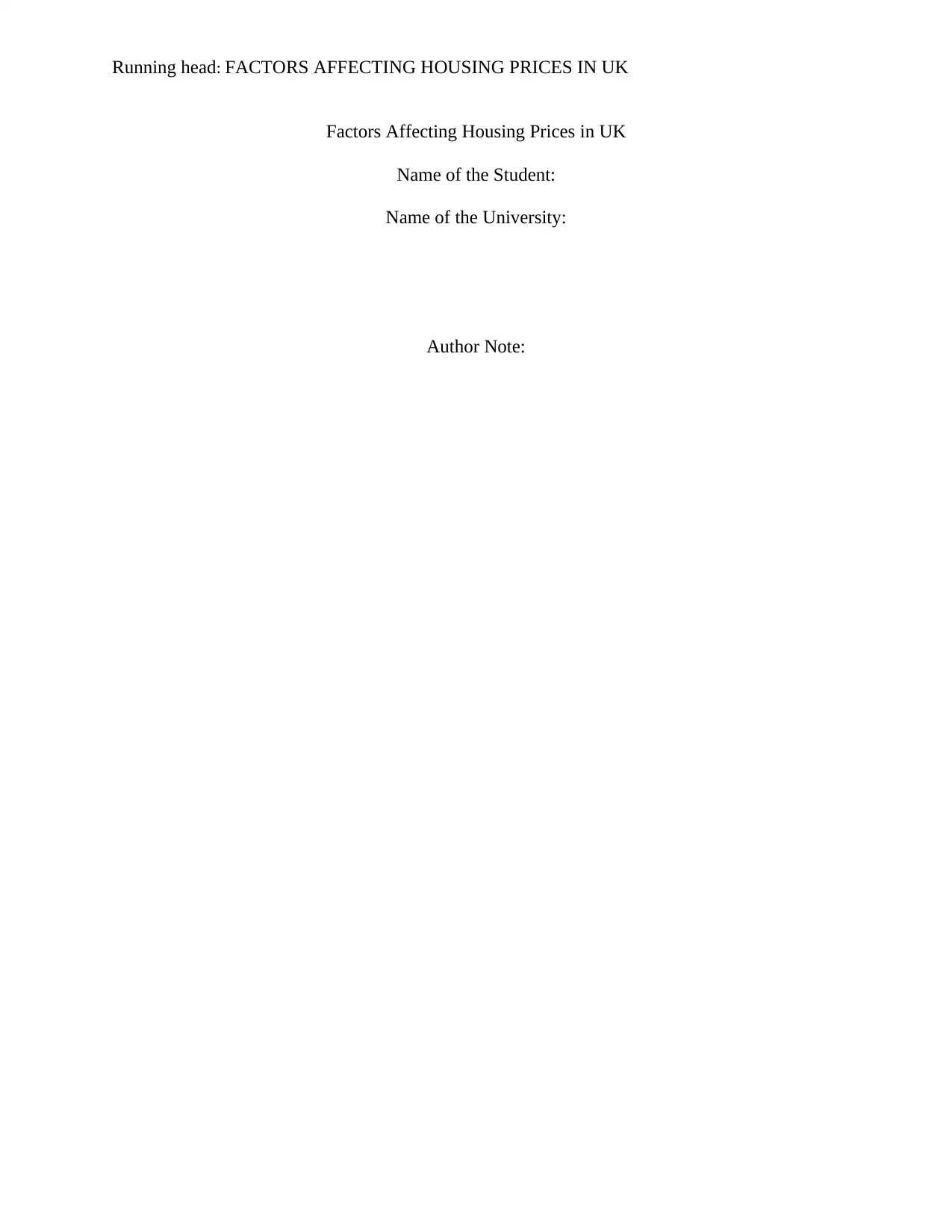
Running head: FACTORS AFFECTING HOUSING PRICES IN UK
Factors Affecting Housing Prices in UK
Name of the Student:
Name of the University:
Author Note:
Factors Affecting Housing Prices in UK
Name of the Student:
Name of the University:
Author Note:
Paraphrase This Document
Need a fresh take? Get an instant paraphrase of this document with our AI Paraphraser
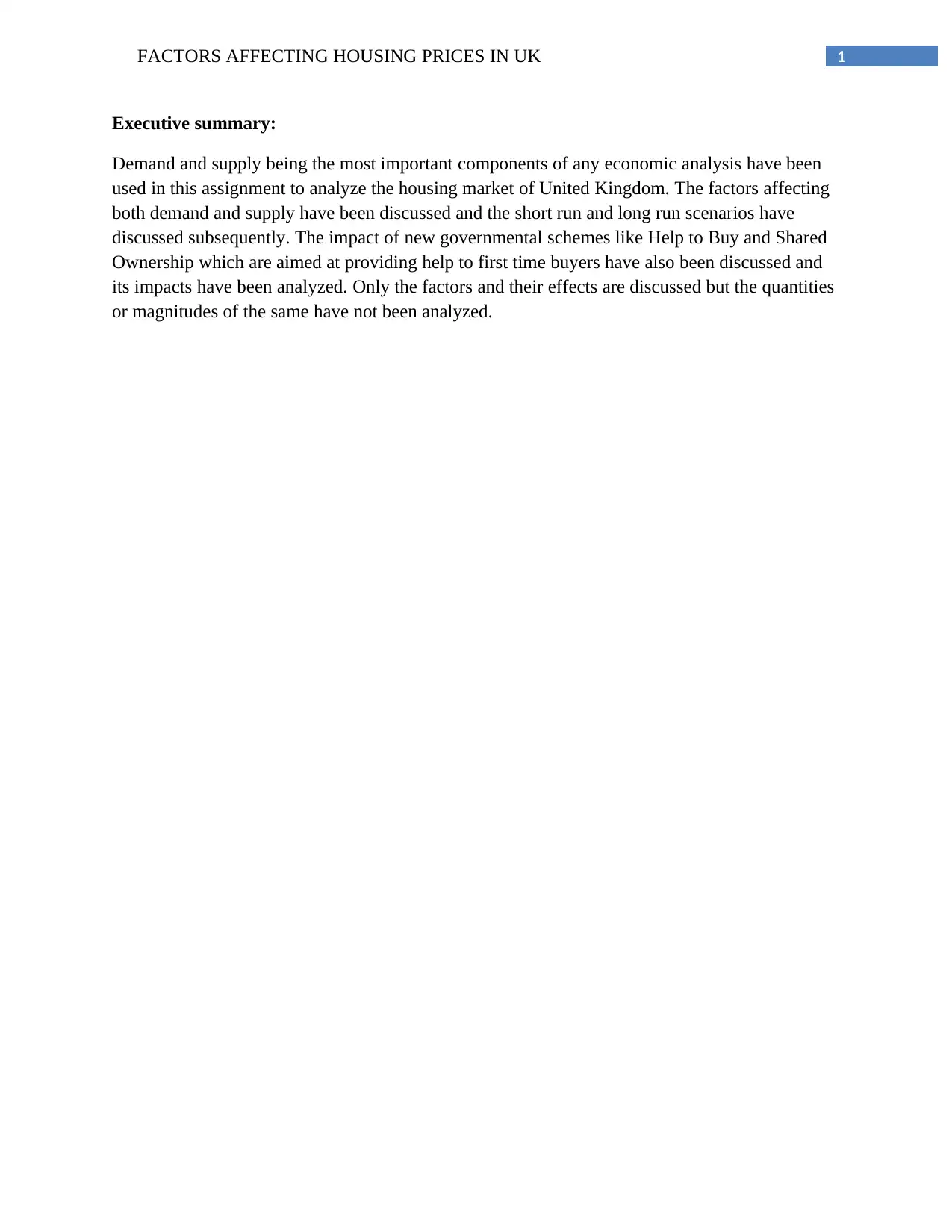
1FACTORS AFFECTING HOUSING PRICES IN UK
Executive summary:
Demand and supply being the most important components of any economic analysis have been
used in this assignment to analyze the housing market of United Kingdom. The factors affecting
both demand and supply have been discussed and the short run and long run scenarios have
discussed subsequently. The impact of new governmental schemes like Help to Buy and Shared
Ownership which are aimed at providing help to first time buyers have also been discussed and
its impacts have been analyzed. Only the factors and their effects are discussed but the quantities
or magnitudes of the same have not been analyzed.
Executive summary:
Demand and supply being the most important components of any economic analysis have been
used in this assignment to analyze the housing market of United Kingdom. The factors affecting
both demand and supply have been discussed and the short run and long run scenarios have
discussed subsequently. The impact of new governmental schemes like Help to Buy and Shared
Ownership which are aimed at providing help to first time buyers have also been discussed and
its impacts have been analyzed. Only the factors and their effects are discussed but the quantities
or magnitudes of the same have not been analyzed.
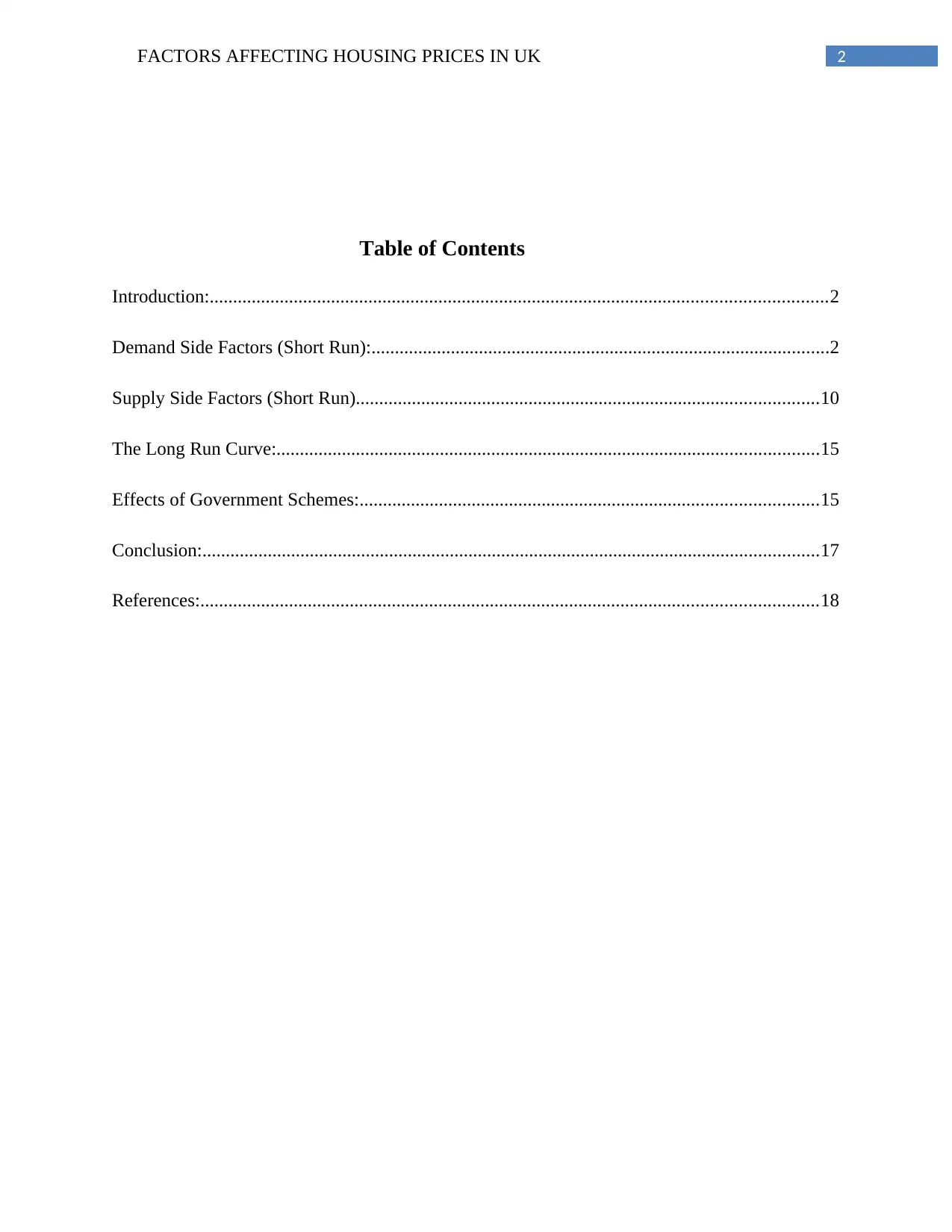
2FACTORS AFFECTING HOUSING PRICES IN UK
Table of Contents
Introduction:....................................................................................................................................2
Demand Side Factors (Short Run):..................................................................................................2
Supply Side Factors (Short Run)...................................................................................................10
The Long Run Curve:....................................................................................................................15
Effects of Government Schemes:..................................................................................................15
Conclusion:....................................................................................................................................17
References:....................................................................................................................................18
Table of Contents
Introduction:....................................................................................................................................2
Demand Side Factors (Short Run):..................................................................................................2
Supply Side Factors (Short Run)...................................................................................................10
The Long Run Curve:....................................................................................................................15
Effects of Government Schemes:..................................................................................................15
Conclusion:....................................................................................................................................17
References:....................................................................................................................................18
You're viewing a preview
Unlock full access by subscribing today!
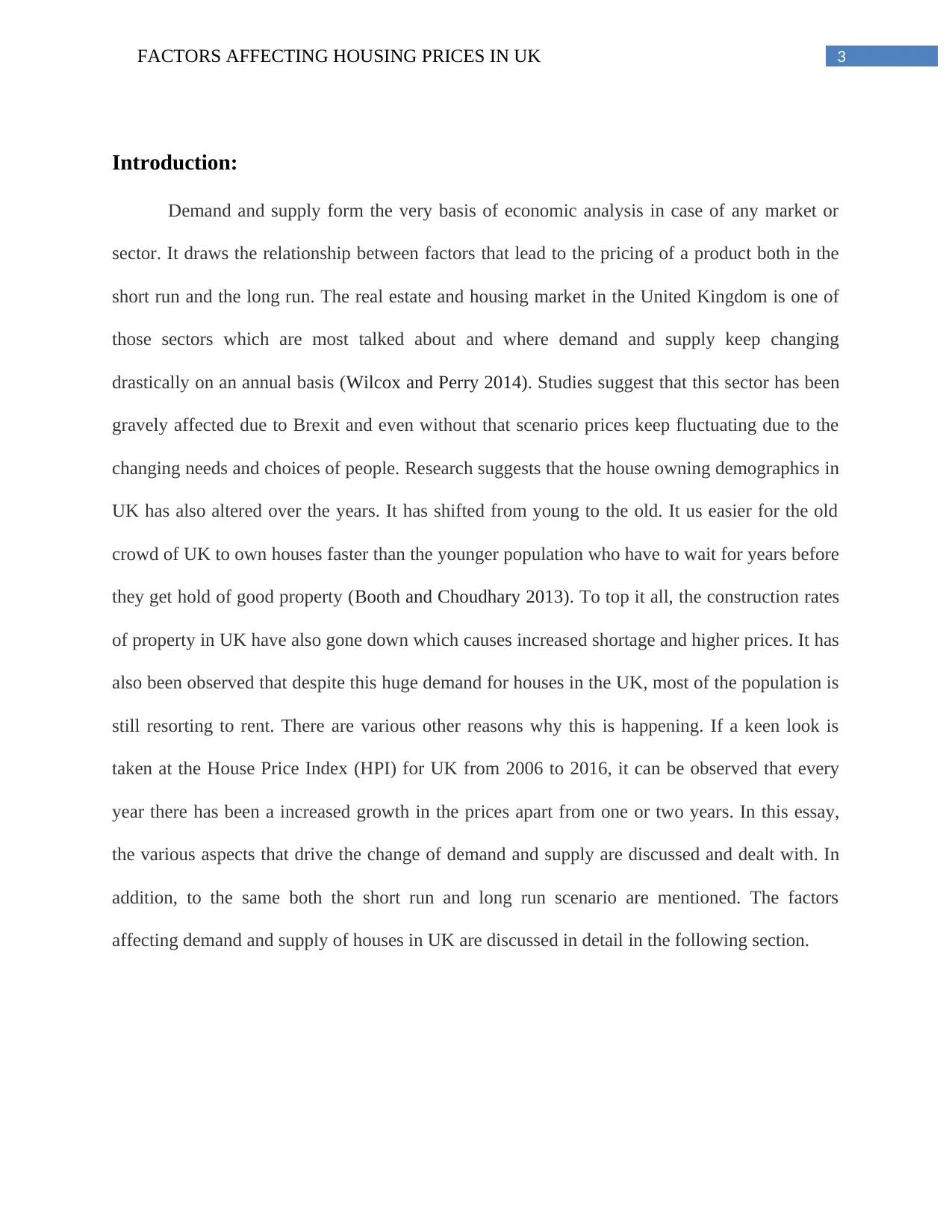
3FACTORS AFFECTING HOUSING PRICES IN UK
Introduction:
Demand and supply form the very basis of economic analysis in case of any market or
sector. It draws the relationship between factors that lead to the pricing of a product both in the
short run and the long run. The real estate and housing market in the United Kingdom is one of
those sectors which are most talked about and where demand and supply keep changing
drastically on an annual basis (Wilcox and Perry 2014). Studies suggest that this sector has been
gravely affected due to Brexit and even without that scenario prices keep fluctuating due to the
changing needs and choices of people. Research suggests that the house owning demographics in
UK has also altered over the years. It has shifted from young to the old. It us easier for the old
crowd of UK to own houses faster than the younger population who have to wait for years before
they get hold of good property (Booth and Choudhary 2013). To top it all, the construction rates
of property in UK have also gone down which causes increased shortage and higher prices. It has
also been observed that despite this huge demand for houses in the UK, most of the population is
still resorting to rent. There are various other reasons why this is happening. If a keen look is
taken at the House Price Index (HPI) for UK from 2006 to 2016, it can be observed that every
year there has been a increased growth in the prices apart from one or two years. In this essay,
the various aspects that drive the change of demand and supply are discussed and dealt with. In
addition, to the same both the short run and long run scenario are mentioned. The factors
affecting demand and supply of houses in UK are discussed in detail in the following section.
Introduction:
Demand and supply form the very basis of economic analysis in case of any market or
sector. It draws the relationship between factors that lead to the pricing of a product both in the
short run and the long run. The real estate and housing market in the United Kingdom is one of
those sectors which are most talked about and where demand and supply keep changing
drastically on an annual basis (Wilcox and Perry 2014). Studies suggest that this sector has been
gravely affected due to Brexit and even without that scenario prices keep fluctuating due to the
changing needs and choices of people. Research suggests that the house owning demographics in
UK has also altered over the years. It has shifted from young to the old. It us easier for the old
crowd of UK to own houses faster than the younger population who have to wait for years before
they get hold of good property (Booth and Choudhary 2013). To top it all, the construction rates
of property in UK have also gone down which causes increased shortage and higher prices. It has
also been observed that despite this huge demand for houses in the UK, most of the population is
still resorting to rent. There are various other reasons why this is happening. If a keen look is
taken at the House Price Index (HPI) for UK from 2006 to 2016, it can be observed that every
year there has been a increased growth in the prices apart from one or two years. In this essay,
the various aspects that drive the change of demand and supply are discussed and dealt with. In
addition, to the same both the short run and long run scenario are mentioned. The factors
affecting demand and supply of houses in UK are discussed in detail in the following section.
Paraphrase This Document
Need a fresh take? Get an instant paraphrase of this document with our AI Paraphraser
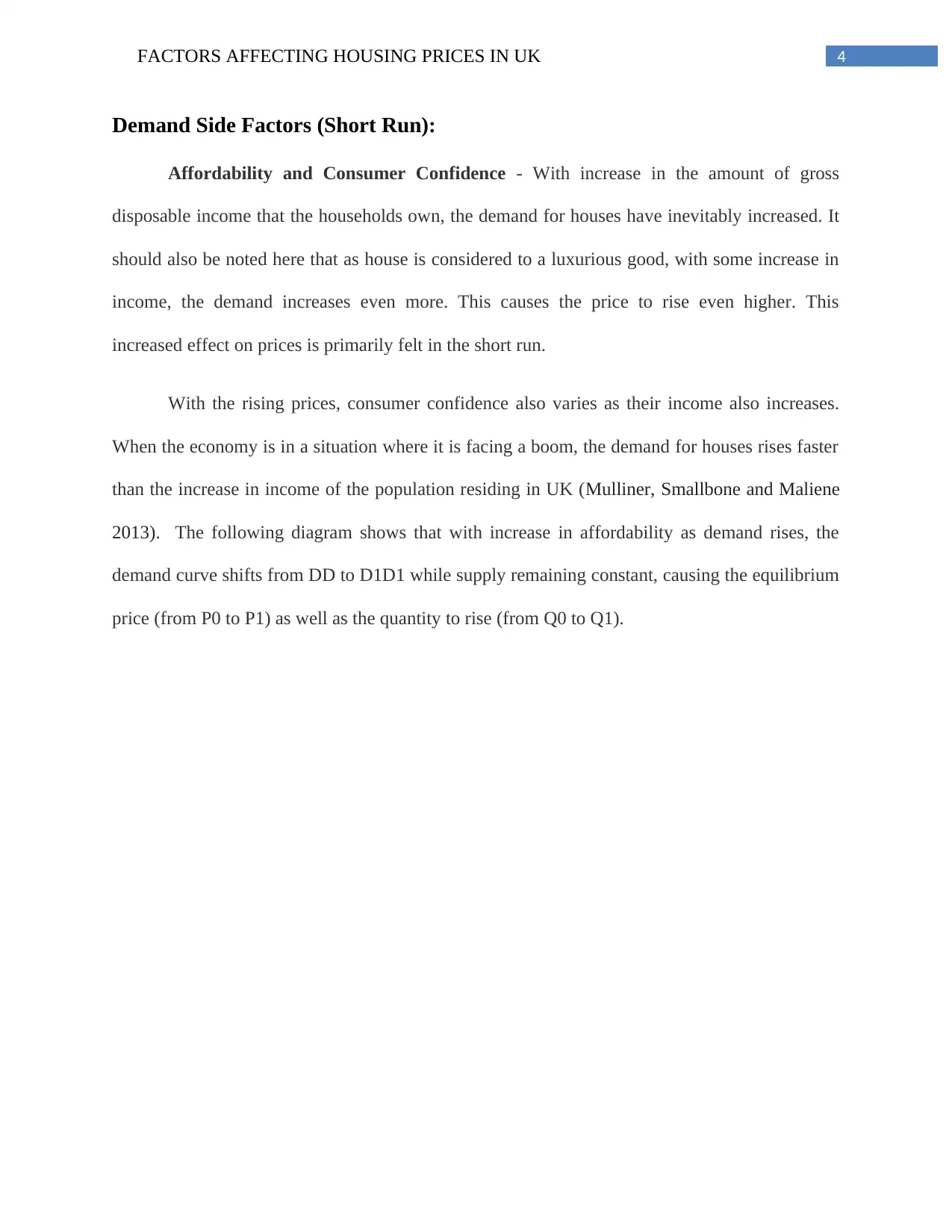
4FACTORS AFFECTING HOUSING PRICES IN UK
Demand Side Factors (Short Run):
Affordability and Consumer Confidence - With increase in the amount of gross
disposable income that the households own, the demand for houses have inevitably increased. It
should also be noted here that as house is considered to a luxurious good, with some increase in
income, the demand increases even more. This causes the price to rise even higher. This
increased effect on prices is primarily felt in the short run.
With the rising prices, consumer confidence also varies as their income also increases.
When the economy is in a situation where it is facing a boom, the demand for houses rises faster
than the increase in income of the population residing in UK (Mulliner, Smallbone and Maliene
2013). The following diagram shows that with increase in affordability as demand rises, the
demand curve shifts from DD to D1D1 while supply remaining constant, causing the equilibrium
price (from P0 to P1) as well as the quantity to rise (from Q0 to Q1).
Demand Side Factors (Short Run):
Affordability and Consumer Confidence - With increase in the amount of gross
disposable income that the households own, the demand for houses have inevitably increased. It
should also be noted here that as house is considered to a luxurious good, with some increase in
income, the demand increases even more. This causes the price to rise even higher. This
increased effect on prices is primarily felt in the short run.
With the rising prices, consumer confidence also varies as their income also increases.
When the economy is in a situation where it is facing a boom, the demand for houses rises faster
than the increase in income of the population residing in UK (Mulliner, Smallbone and Maliene
2013). The following diagram shows that with increase in affordability as demand rises, the
demand curve shifts from DD to D1D1 while supply remaining constant, causing the equilibrium
price (from P0 to P1) as well as the quantity to rise (from Q0 to Q1).
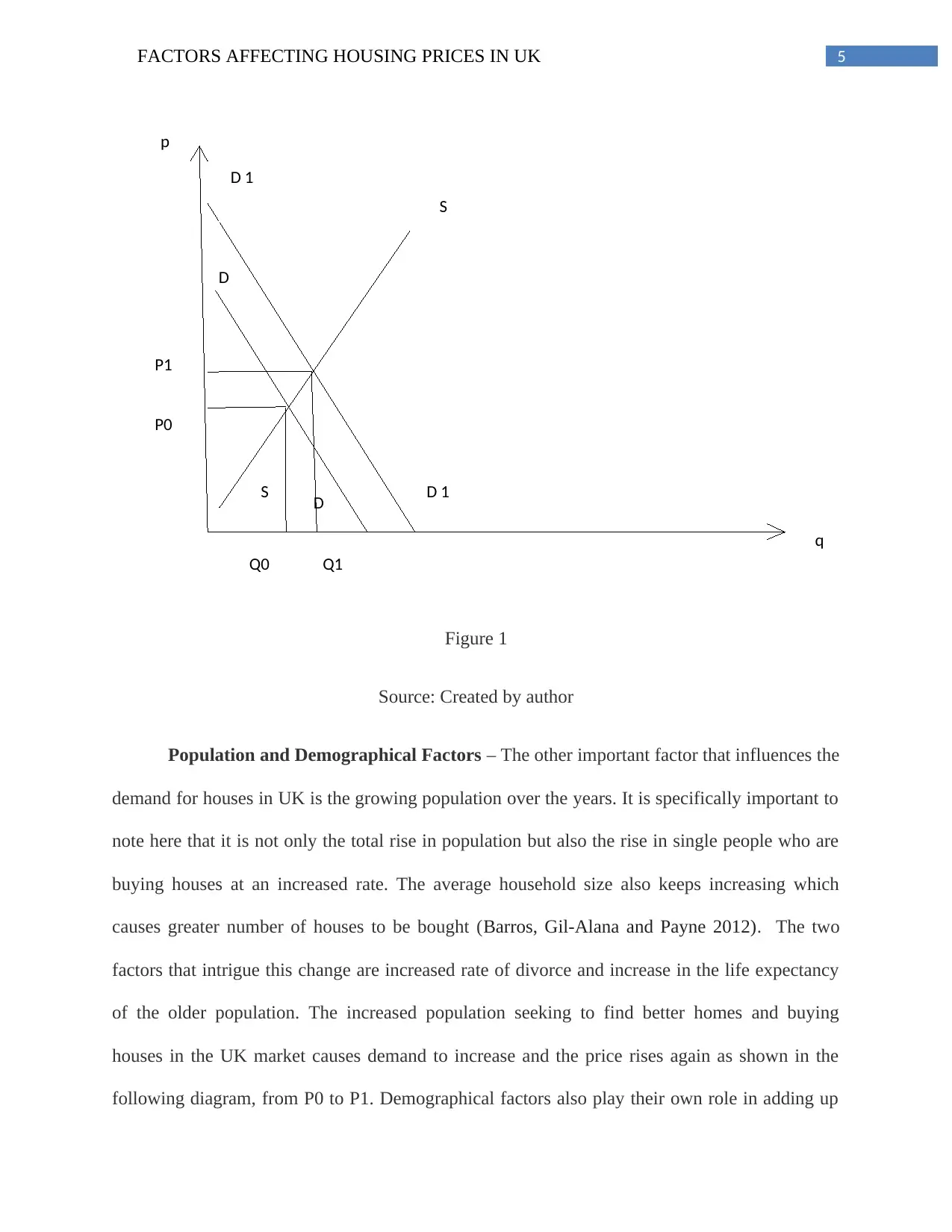
5FACTORS AFFECTING HOUSING PRICES IN UK
q
p
S
S
D 1
D 1
D
D
P0
P1
Q0 Q1
Figure 1
Source: Created by author
Population and Demographical Factors – The other important factor that influences the
demand for houses in UK is the growing population over the years. It is specifically important to
note here that it is not only the total rise in population but also the rise in single people who are
buying houses at an increased rate. The average household size also keeps increasing which
causes greater number of houses to be bought (Barros, Gil-Alana and Payne 2012). The two
factors that intrigue this change are increased rate of divorce and increase in the life expectancy
of the older population. The increased population seeking to find better homes and buying
houses in the UK market causes demand to increase and the price rises again as shown in the
following diagram, from P0 to P1. Demographical factors also play their own role in adding up
q
p
S
S
D 1
D 1
D
D
P0
P1
Q0 Q1
Figure 1
Source: Created by author
Population and Demographical Factors – The other important factor that influences the
demand for houses in UK is the growing population over the years. It is specifically important to
note here that it is not only the total rise in population but also the rise in single people who are
buying houses at an increased rate. The average household size also keeps increasing which
causes greater number of houses to be bought (Barros, Gil-Alana and Payne 2012). The two
factors that intrigue this change are increased rate of divorce and increase in the life expectancy
of the older population. The increased population seeking to find better homes and buying
houses in the UK market causes demand to increase and the price rises again as shown in the
following diagram, from P0 to P1. Demographical factors also play their own role in adding up
You're viewing a preview
Unlock full access by subscribing today!
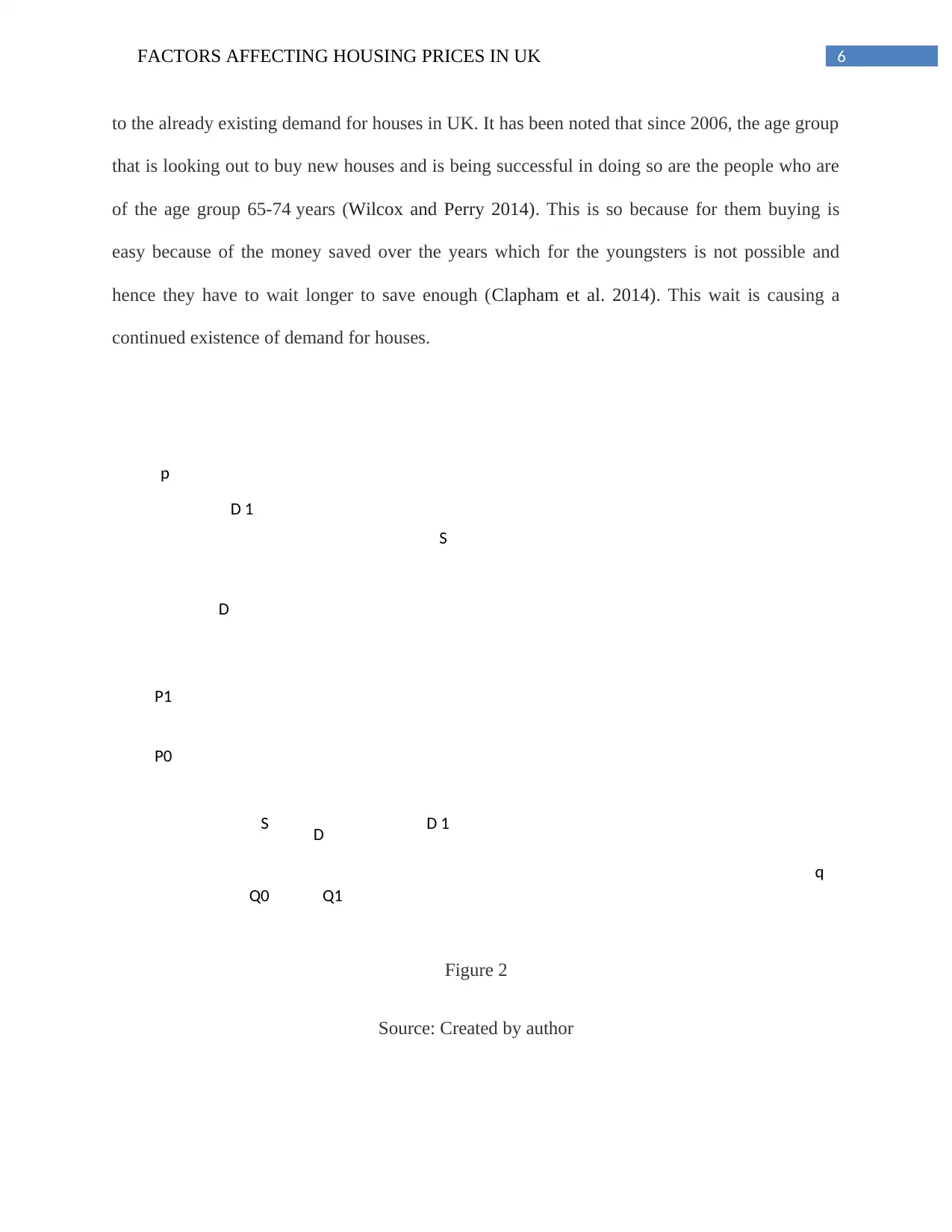
6FACTORS AFFECTING HOUSING PRICES IN UK
q
p
S
S
D 1
D 1
D
D
P0
P1
Q0 Q1
to the already existing demand for houses in UK. It has been noted that since 2006, the age group
that is looking out to buy new houses and is being successful in doing so are the people who are
of the age group 65-74 years (Wilcox and Perry 2014). This is so because for them buying is
easy because of the money saved over the years which for the youngsters is not possible and
hence they have to wait longer to save enough (Clapham et al. 2014). This wait is causing a
continued existence of demand for houses.
Figure 2
Source: Created by author
q
p
S
S
D 1
D 1
D
D
P0
P1
Q0 Q1
to the already existing demand for houses in UK. It has been noted that since 2006, the age group
that is looking out to buy new houses and is being successful in doing so are the people who are
of the age group 65-74 years (Wilcox and Perry 2014). This is so because for them buying is
easy because of the money saved over the years which for the youngsters is not possible and
hence they have to wait longer to save enough (Clapham et al. 2014). This wait is causing a
continued existence of demand for houses.
Figure 2
Source: Created by author
Paraphrase This Document
Need a fresh take? Get an instant paraphrase of this document with our AI Paraphraser
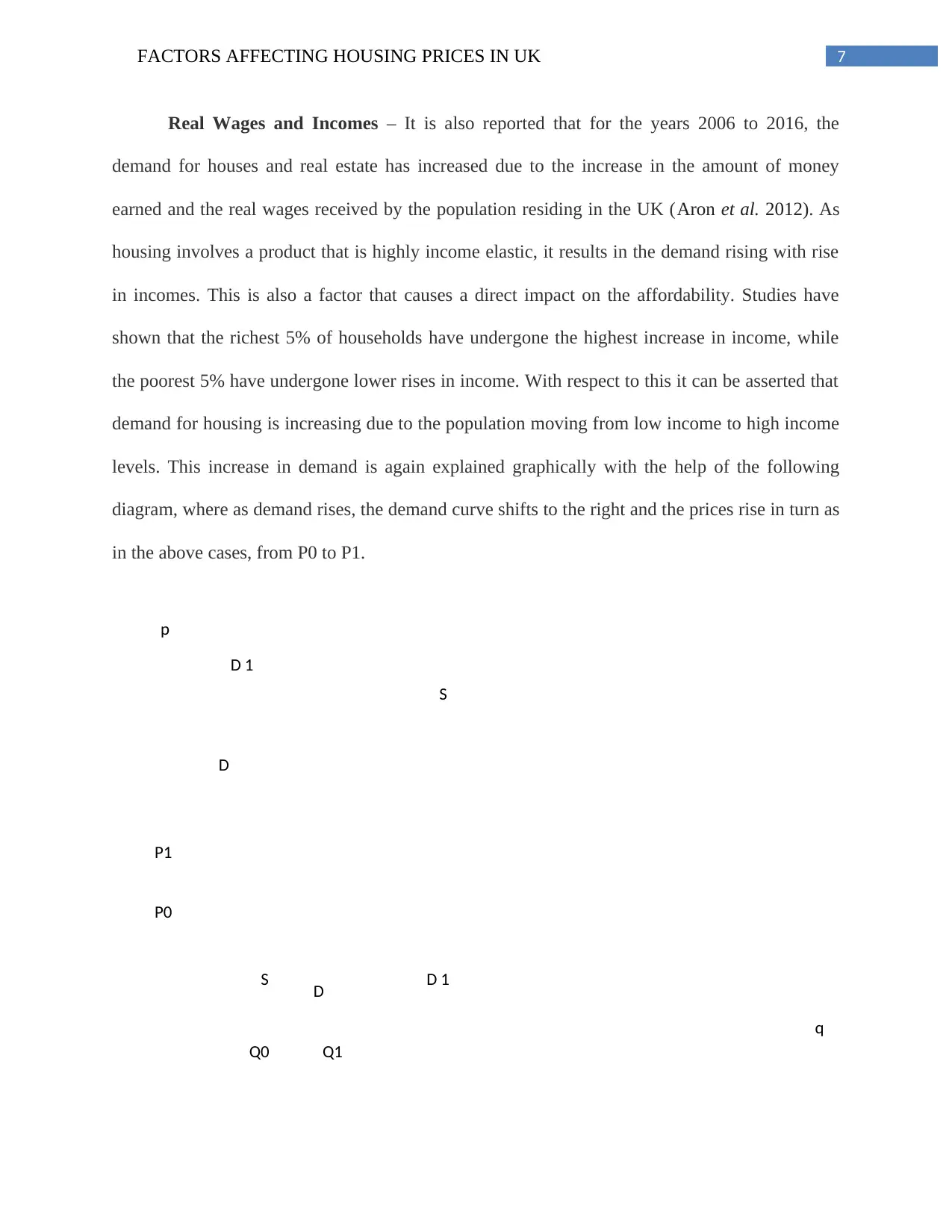
7FACTORS AFFECTING HOUSING PRICES IN UK
q
p
S
S
D 1
D 1
D
D
P0
P1
Q0 Q1
Real Wages and Incomes – It is also reported that for the years 2006 to 2016, the
demand for houses and real estate has increased due to the increase in the amount of money
earned and the real wages received by the population residing in the UK (Aron et al. 2012). As
housing involves a product that is highly income elastic, it results in the demand rising with rise
in incomes. This is also a factor that causes a direct impact on the affordability. Studies have
shown that the richest 5% of households have undergone the highest increase in income, while
the poorest 5% have undergone lower rises in income. With respect to this it can be asserted that
demand for housing is increasing due to the population moving from low income to high income
levels. This increase in demand is again explained graphically with the help of the following
diagram, where as demand rises, the demand curve shifts to the right and the prices rise in turn as
in the above cases, from P0 to P1.
q
p
S
S
D 1
D 1
D
D
P0
P1
Q0 Q1
Real Wages and Incomes – It is also reported that for the years 2006 to 2016, the
demand for houses and real estate has increased due to the increase in the amount of money
earned and the real wages received by the population residing in the UK (Aron et al. 2012). As
housing involves a product that is highly income elastic, it results in the demand rising with rise
in incomes. This is also a factor that causes a direct impact on the affordability. Studies have
shown that the richest 5% of households have undergone the highest increase in income, while
the poorest 5% have undergone lower rises in income. With respect to this it can be asserted that
demand for housing is increasing due to the population moving from low income to high income
levels. This increase in demand is again explained graphically with the help of the following
diagram, where as demand rises, the demand curve shifts to the right and the prices rise in turn as
in the above cases, from P0 to P1.
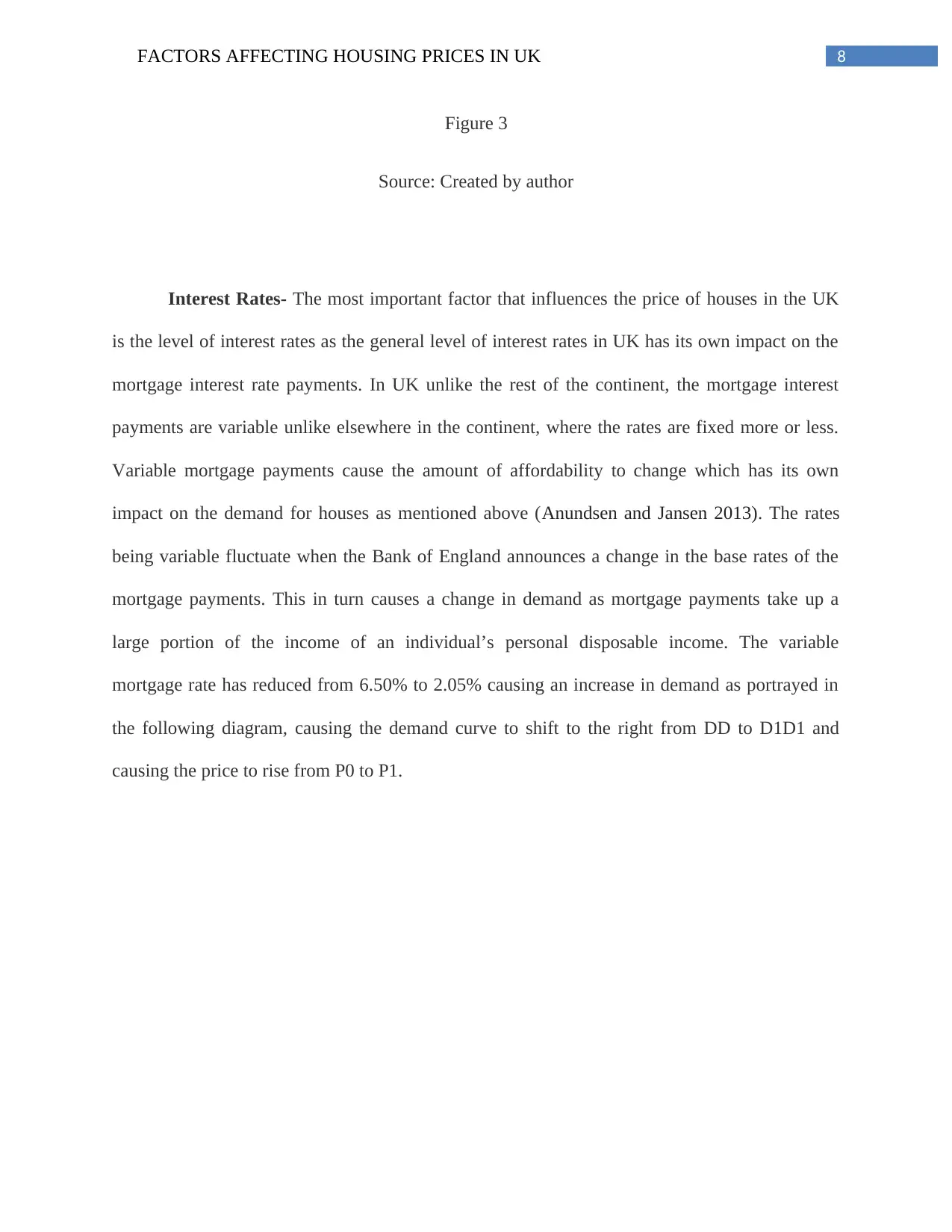
8FACTORS AFFECTING HOUSING PRICES IN UK
Figure 3
Source: Created by author
Interest Rates- The most important factor that influences the price of houses in the UK
is the level of interest rates as the general level of interest rates in UK has its own impact on the
mortgage interest rate payments. In UK unlike the rest of the continent, the mortgage interest
payments are variable unlike elsewhere in the continent, where the rates are fixed more or less.
Variable mortgage payments cause the amount of affordability to change which has its own
impact on the demand for houses as mentioned above (Anundsen and Jansen 2013). The rates
being variable fluctuate when the Bank of England announces a change in the base rates of the
mortgage payments. This in turn causes a change in demand as mortgage payments take up a
large portion of the income of an individual’s personal disposable income. The variable
mortgage rate has reduced from 6.50% to 2.05% causing an increase in demand as portrayed in
the following diagram, causing the demand curve to shift to the right from DD to D1D1 and
causing the price to rise from P0 to P1.
Figure 3
Source: Created by author
Interest Rates- The most important factor that influences the price of houses in the UK
is the level of interest rates as the general level of interest rates in UK has its own impact on the
mortgage interest rate payments. In UK unlike the rest of the continent, the mortgage interest
payments are variable unlike elsewhere in the continent, where the rates are fixed more or less.
Variable mortgage payments cause the amount of affordability to change which has its own
impact on the demand for houses as mentioned above (Anundsen and Jansen 2013). The rates
being variable fluctuate when the Bank of England announces a change in the base rates of the
mortgage payments. This in turn causes a change in demand as mortgage payments take up a
large portion of the income of an individual’s personal disposable income. The variable
mortgage rate has reduced from 6.50% to 2.05% causing an increase in demand as portrayed in
the following diagram, causing the demand curve to shift to the right from DD to D1D1 and
causing the price to rise from P0 to P1.
You're viewing a preview
Unlock full access by subscribing today!
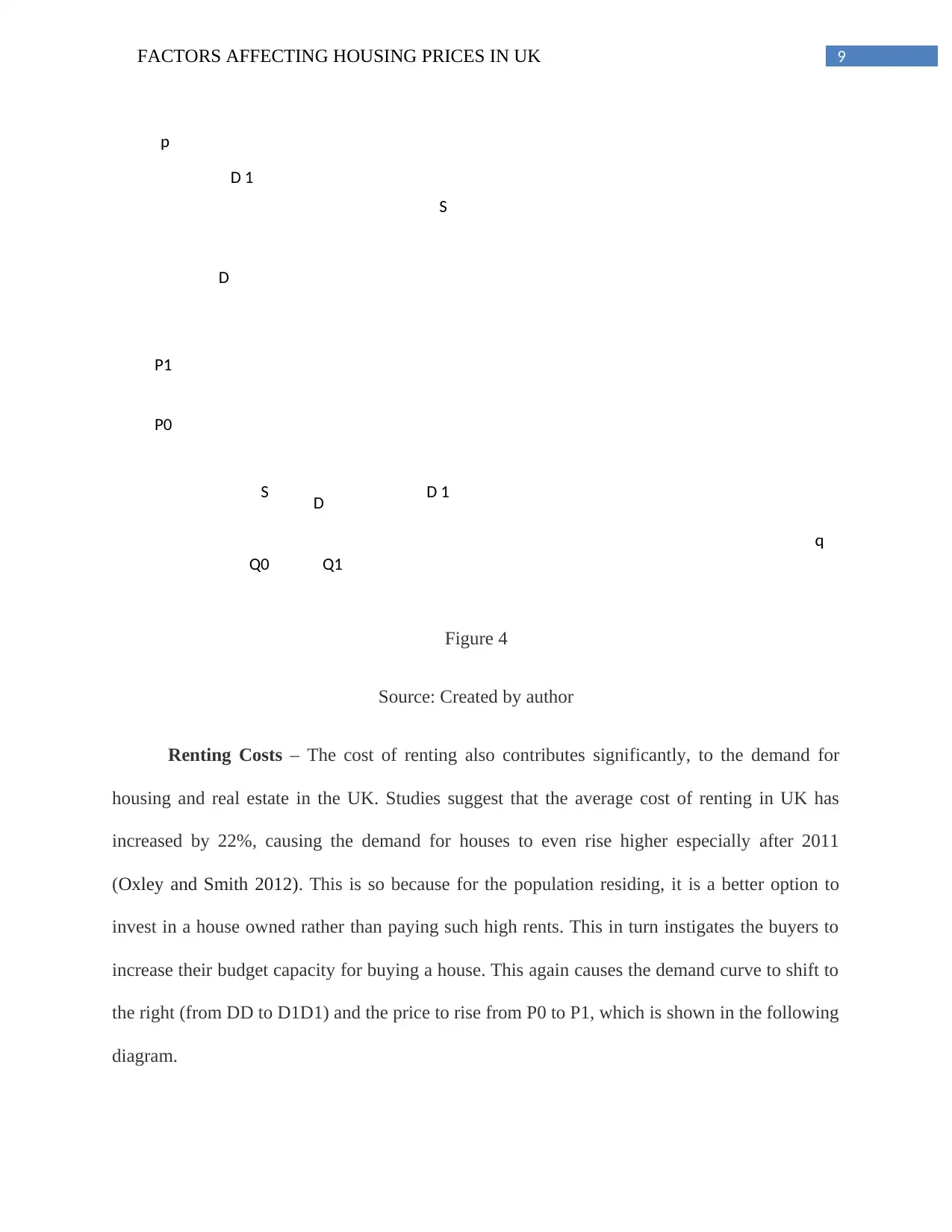
9FACTORS AFFECTING HOUSING PRICES IN UK
q
p
S
S
D 1
D 1
D
D
P0
P1
Q0 Q1
Figure 4
Source: Created by author
Renting Costs – The cost of renting also contributes significantly, to the demand for
housing and real estate in the UK. Studies suggest that the average cost of renting in UK has
increased by 22%, causing the demand for houses to even rise higher especially after 2011
(Oxley and Smith 2012). This is so because for the population residing, it is a better option to
invest in a house owned rather than paying such high rents. This in turn instigates the buyers to
increase their budget capacity for buying a house. This again causes the demand curve to shift to
the right (from DD to D1D1) and the price to rise from P0 to P1, which is shown in the following
diagram.
q
p
S
S
D 1
D 1
D
D
P0
P1
Q0 Q1
Figure 4
Source: Created by author
Renting Costs – The cost of renting also contributes significantly, to the demand for
housing and real estate in the UK. Studies suggest that the average cost of renting in UK has
increased by 22%, causing the demand for houses to even rise higher especially after 2011
(Oxley and Smith 2012). This is so because for the population residing, it is a better option to
invest in a house owned rather than paying such high rents. This in turn instigates the buyers to
increase their budget capacity for buying a house. This again causes the demand curve to shift to
the right (from DD to D1D1) and the price to rise from P0 to P1, which is shown in the following
diagram.
Paraphrase This Document
Need a fresh take? Get an instant paraphrase of this document with our AI Paraphraser
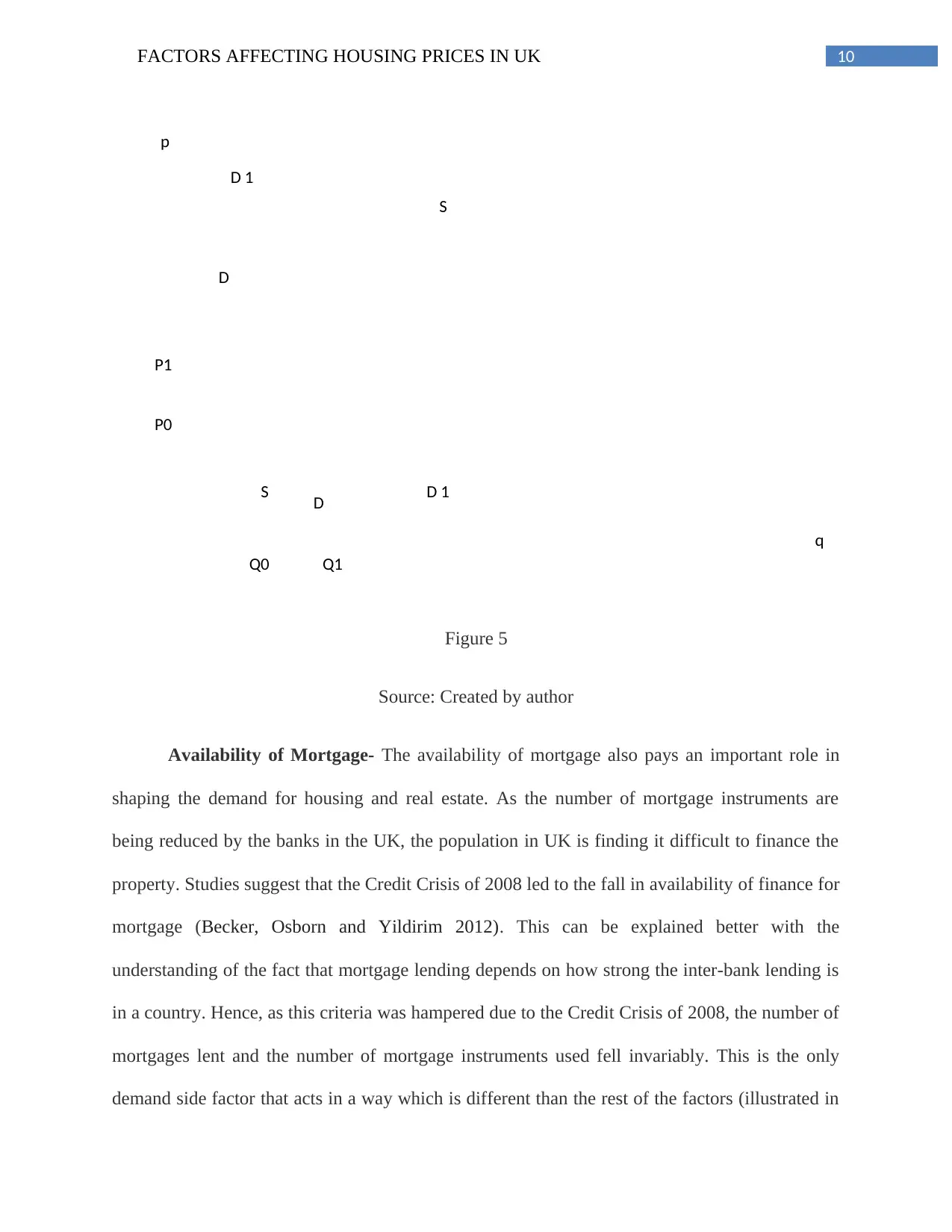
10FACTORS AFFECTING HOUSING PRICES IN UK
q
p
S
S
D 1
D 1
D
D
P0
P1
Q0 Q1
Figure 5
Source: Created by author
Availability of Mortgage- The availability of mortgage also pays an important role in
shaping the demand for housing and real estate. As the number of mortgage instruments are
being reduced by the banks in the UK, the population in UK is finding it difficult to finance the
property. Studies suggest that the Credit Crisis of 2008 led to the fall in availability of finance for
mortgage (Becker, Osborn and Yildirim 2012). This can be explained better with the
understanding of the fact that mortgage lending depends on how strong the inter-bank lending is
in a country. Hence, as this criteria was hampered due to the Credit Crisis of 2008, the number of
mortgages lent and the number of mortgage instruments used fell invariably. This is the only
demand side factor that acts in a way which is different than the rest of the factors (illustrated in
q
p
S
S
D 1
D 1
D
D
P0
P1
Q0 Q1
Figure 5
Source: Created by author
Availability of Mortgage- The availability of mortgage also pays an important role in
shaping the demand for housing and real estate. As the number of mortgage instruments are
being reduced by the banks in the UK, the population in UK is finding it difficult to finance the
property. Studies suggest that the Credit Crisis of 2008 led to the fall in availability of finance for
mortgage (Becker, Osborn and Yildirim 2012). This can be explained better with the
understanding of the fact that mortgage lending depends on how strong the inter-bank lending is
in a country. Hence, as this criteria was hampered due to the Credit Crisis of 2008, the number of
mortgages lent and the number of mortgage instruments used fell invariably. This is the only
demand side factor that acts in a way which is different than the rest of the factors (illustrated in
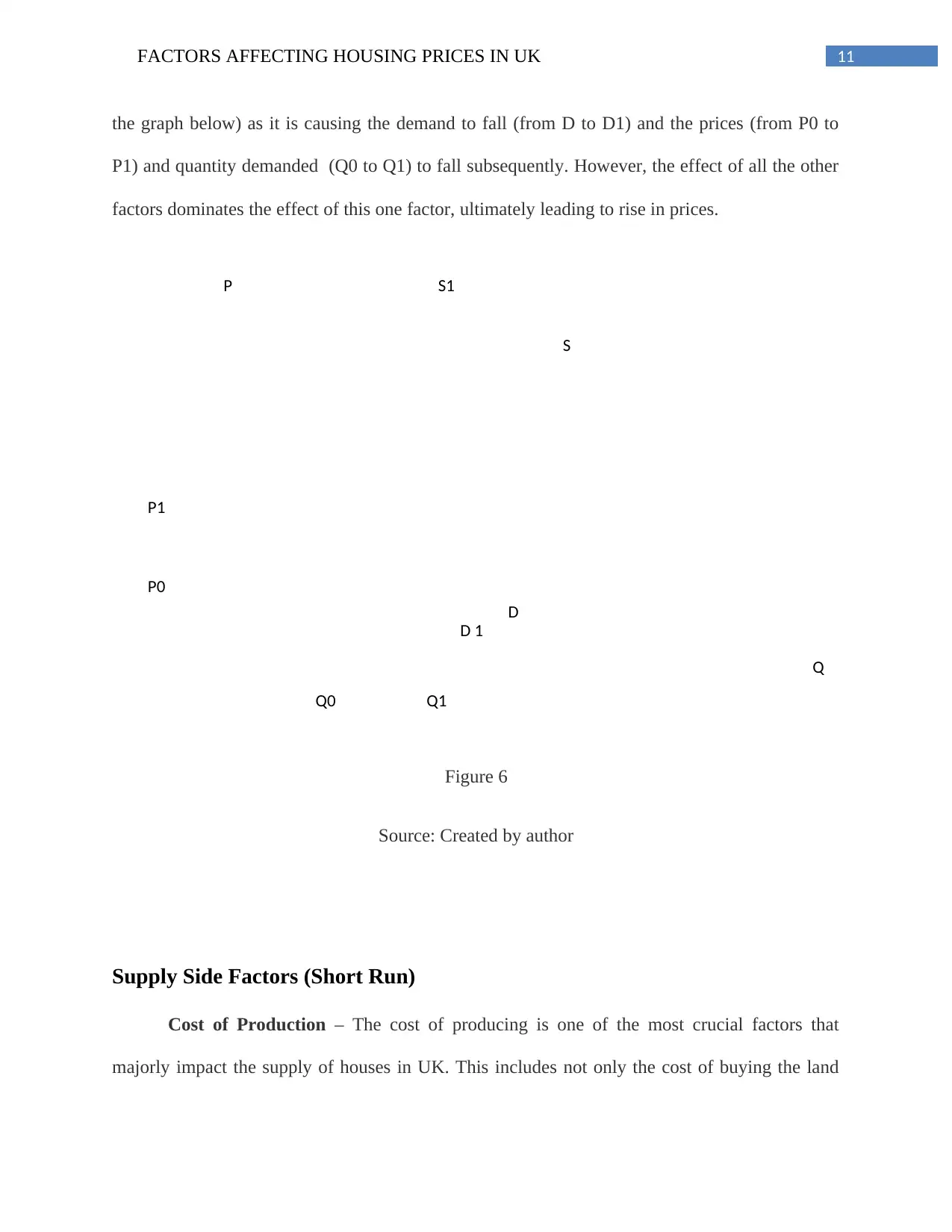
11FACTORS AFFECTING HOUSING PRICES IN UK
P
Q
P1
P0
Q0 Q1
S
S1
D 1
D
the graph below) as it is causing the demand to fall (from D to D1) and the prices (from P0 to
P1) and quantity demanded (Q0 to Q1) to fall subsequently. However, the effect of all the other
factors dominates the effect of this one factor, ultimately leading to rise in prices.
Figure 6
Source: Created by author
Supply Side Factors (Short Run)
Cost of Production – The cost of producing is one of the most crucial factors that
majorly impact the supply of houses in UK. This includes not only the cost of buying the land
P
Q
P1
P0
Q0 Q1
S
S1
D 1
D
the graph below) as it is causing the demand to fall (from D to D1) and the prices (from P0 to
P1) and quantity demanded (Q0 to Q1) to fall subsequently. However, the effect of all the other
factors dominates the effect of this one factor, ultimately leading to rise in prices.
Figure 6
Source: Created by author
Supply Side Factors (Short Run)
Cost of Production – The cost of producing is one of the most crucial factors that
majorly impact the supply of houses in UK. This includes not only the cost of buying the land
You're viewing a preview
Unlock full access by subscribing today!
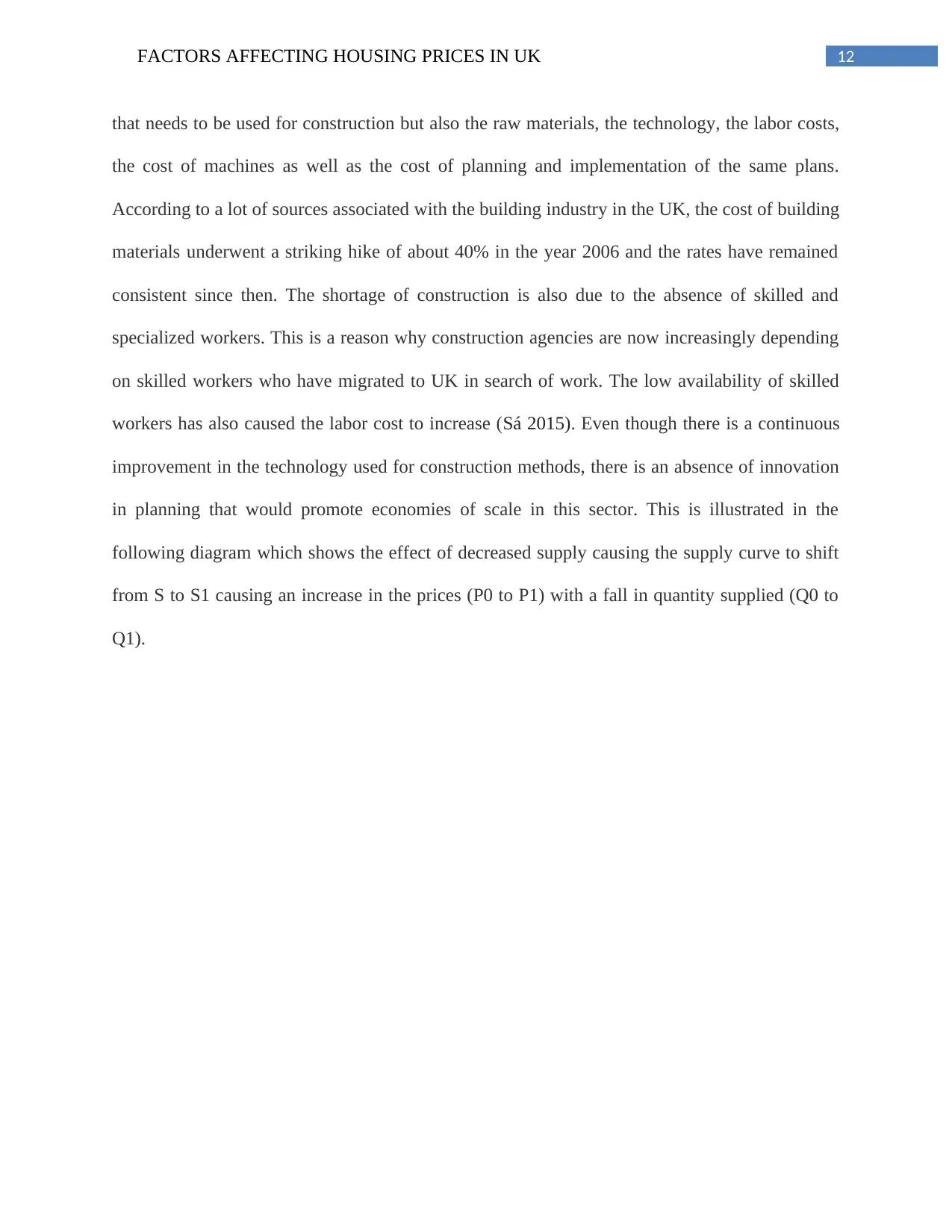
12FACTORS AFFECTING HOUSING PRICES IN UK
that needs to be used for construction but also the raw materials, the technology, the labor costs,
the cost of machines as well as the cost of planning and implementation of the same plans.
According to a lot of sources associated with the building industry in the UK, the cost of building
materials underwent a striking hike of about 40% in the year 2006 and the rates have remained
consistent since then. The shortage of construction is also due to the absence of skilled and
specialized workers. This is a reason why construction agencies are now increasingly depending
on skilled workers who have migrated to UK in search of work. The low availability of skilled
workers has also caused the labor cost to increase (Sá 2015). Even though there is a continuous
improvement in the technology used for construction methods, there is an absence of innovation
in planning that would promote economies of scale in this sector. This is illustrated in the
following diagram which shows the effect of decreased supply causing the supply curve to shift
from S to S1 causing an increase in the prices (P0 to P1) with a fall in quantity supplied (Q0 to
Q1).
that needs to be used for construction but also the raw materials, the technology, the labor costs,
the cost of machines as well as the cost of planning and implementation of the same plans.
According to a lot of sources associated with the building industry in the UK, the cost of building
materials underwent a striking hike of about 40% in the year 2006 and the rates have remained
consistent since then. The shortage of construction is also due to the absence of skilled and
specialized workers. This is a reason why construction agencies are now increasingly depending
on skilled workers who have migrated to UK in search of work. The low availability of skilled
workers has also caused the labor cost to increase (Sá 2015). Even though there is a continuous
improvement in the technology used for construction methods, there is an absence of innovation
in planning that would promote economies of scale in this sector. This is illustrated in the
following diagram which shows the effect of decreased supply causing the supply curve to shift
from S to S1 causing an increase in the prices (P0 to P1) with a fall in quantity supplied (Q0 to
Q1).
Paraphrase This Document
Need a fresh take? Get an instant paraphrase of this document with our AI Paraphraser
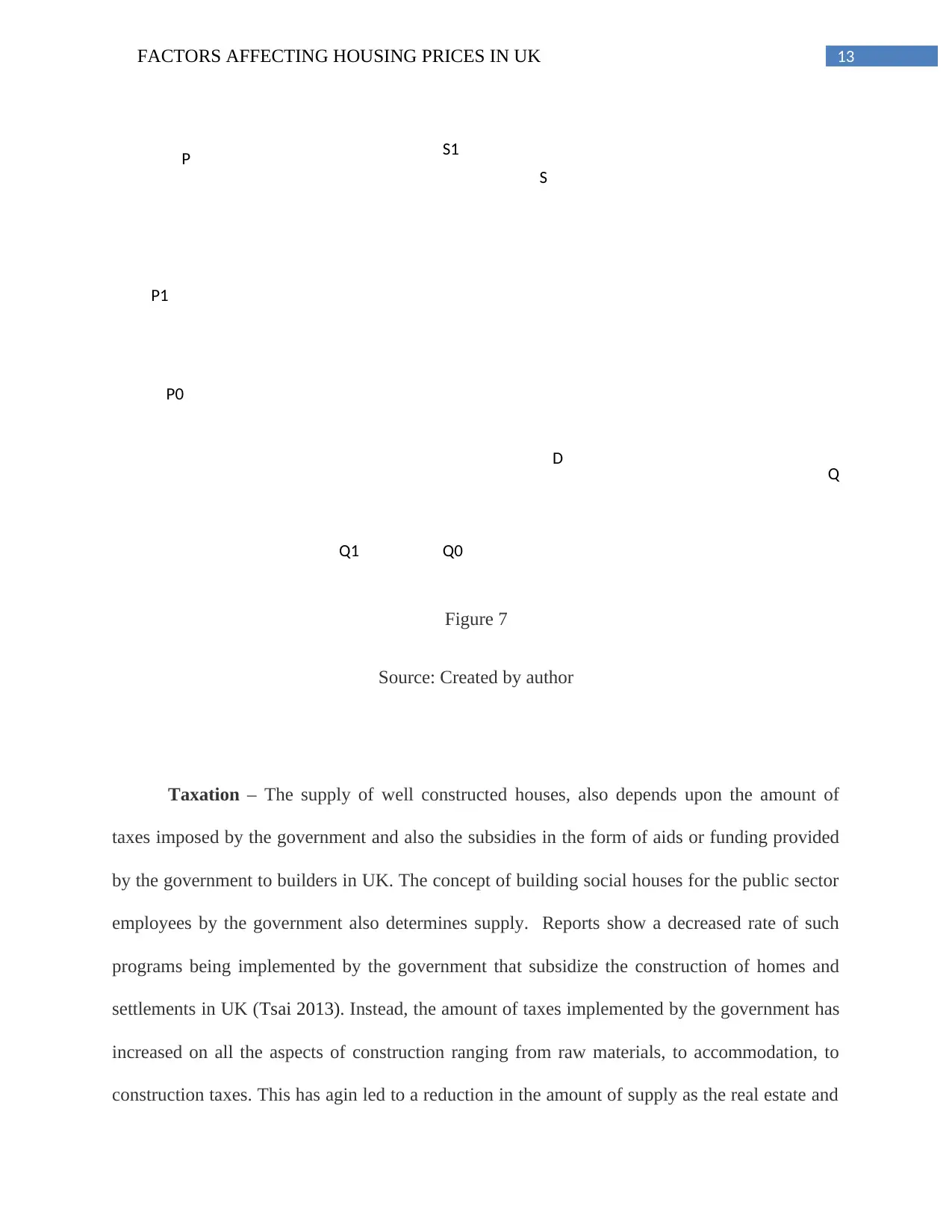
13FACTORS AFFECTING HOUSING PRICES IN UK
S1
S
D
P
Q
Q1 Q0
P1
P0
Figure 7
Source: Created by author
Taxation – The supply of well constructed houses, also depends upon the amount of
taxes imposed by the government and also the subsidies in the form of aids or funding provided
by the government to builders in UK. The concept of building social houses for the public sector
employees by the government also determines supply. Reports show a decreased rate of such
programs being implemented by the government that subsidize the construction of homes and
settlements in UK (Tsai 2013). Instead, the amount of taxes implemented by the government has
increased on all the aspects of construction ranging from raw materials, to accommodation, to
construction taxes. This has agin led to a reduction in the amount of supply as the real estate and
S1
S
D
P
Q
Q1 Q0
P1
P0
Figure 7
Source: Created by author
Taxation – The supply of well constructed houses, also depends upon the amount of
taxes imposed by the government and also the subsidies in the form of aids or funding provided
by the government to builders in UK. The concept of building social houses for the public sector
employees by the government also determines supply. Reports show a decreased rate of such
programs being implemented by the government that subsidize the construction of homes and
settlements in UK (Tsai 2013). Instead, the amount of taxes implemented by the government has
increased on all the aspects of construction ranging from raw materials, to accommodation, to
construction taxes. This has agin led to a reduction in the amount of supply as the real estate and

14FACTORS AFFECTING HOUSING PRICES IN UK
S1
S
D
P
Q
Q1 Q0
P1
P0
construction of housing is being deemed to be a risky sector when it comes to investments. This
is resulting in diminished supply causing the supply curve of the economy to shift to the left as
illustrated below (from S to S1) which in turn is causing a hike in prices from (P0 to P1) and a
fall in the quantity supplied.
Figure 8
Source: Created by author
S1
S
D
P
Q
Q1 Q0
P1
P0
construction of housing is being deemed to be a risky sector when it comes to investments. This
is resulting in diminished supply causing the supply curve of the economy to shift to the left as
illustrated below (from S to S1) which in turn is causing a hike in prices from (P0 to P1) and a
fall in the quantity supplied.
Figure 8
Source: Created by author
You're viewing a preview
Unlock full access by subscribing today!
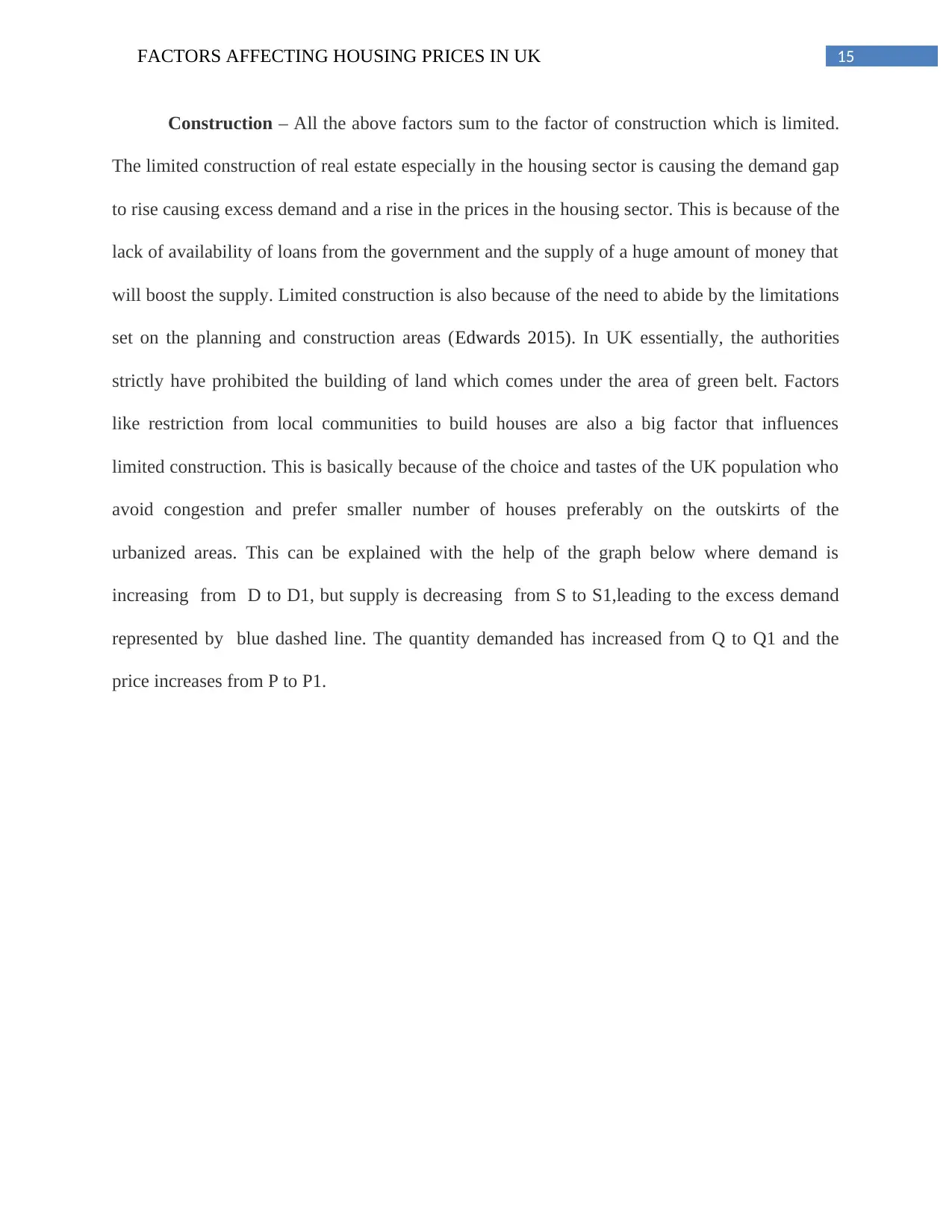
15FACTORS AFFECTING HOUSING PRICES IN UK
Construction – All the above factors sum to the factor of construction which is limited.
The limited construction of real estate especially in the housing sector is causing the demand gap
to rise causing excess demand and a rise in the prices in the housing sector. This is because of the
lack of availability of loans from the government and the supply of a huge amount of money that
will boost the supply. Limited construction is also because of the need to abide by the limitations
set on the planning and construction areas (Edwards 2015). In UK essentially, the authorities
strictly have prohibited the building of land which comes under the area of green belt. Factors
like restriction from local communities to build houses are also a big factor that influences
limited construction. This is basically because of the choice and tastes of the UK population who
avoid congestion and prefer smaller number of houses preferably on the outskirts of the
urbanized areas. This can be explained with the help of the graph below where demand is
increasing from D to D1, but supply is decreasing from S to S1,leading to the excess demand
represented by blue dashed line. The quantity demanded has increased from Q to Q1 and the
price increases from P to P1.
Construction – All the above factors sum to the factor of construction which is limited.
The limited construction of real estate especially in the housing sector is causing the demand gap
to rise causing excess demand and a rise in the prices in the housing sector. This is because of the
lack of availability of loans from the government and the supply of a huge amount of money that
will boost the supply. Limited construction is also because of the need to abide by the limitations
set on the planning and construction areas (Edwards 2015). In UK essentially, the authorities
strictly have prohibited the building of land which comes under the area of green belt. Factors
like restriction from local communities to build houses are also a big factor that influences
limited construction. This is basically because of the choice and tastes of the UK population who
avoid congestion and prefer smaller number of houses preferably on the outskirts of the
urbanized areas. This can be explained with the help of the graph below where demand is
increasing from D to D1, but supply is decreasing from S to S1,leading to the excess demand
represented by blue dashed line. The quantity demanded has increased from Q to Q1 and the
price increases from P to P1.
Paraphrase This Document
Need a fresh take? Get an instant paraphrase of this document with our AI Paraphraser

16FACTORS AFFECTING HOUSING PRICES IN UK
P
Q
P1
P0
Q0 Q1
S
S1
D
D1
Lo
Figure 9
Source: Created by author
P
Q
P1
P0
Q0 Q1
S
S1
D
D1
Lo
Figure 9
Source: Created by author
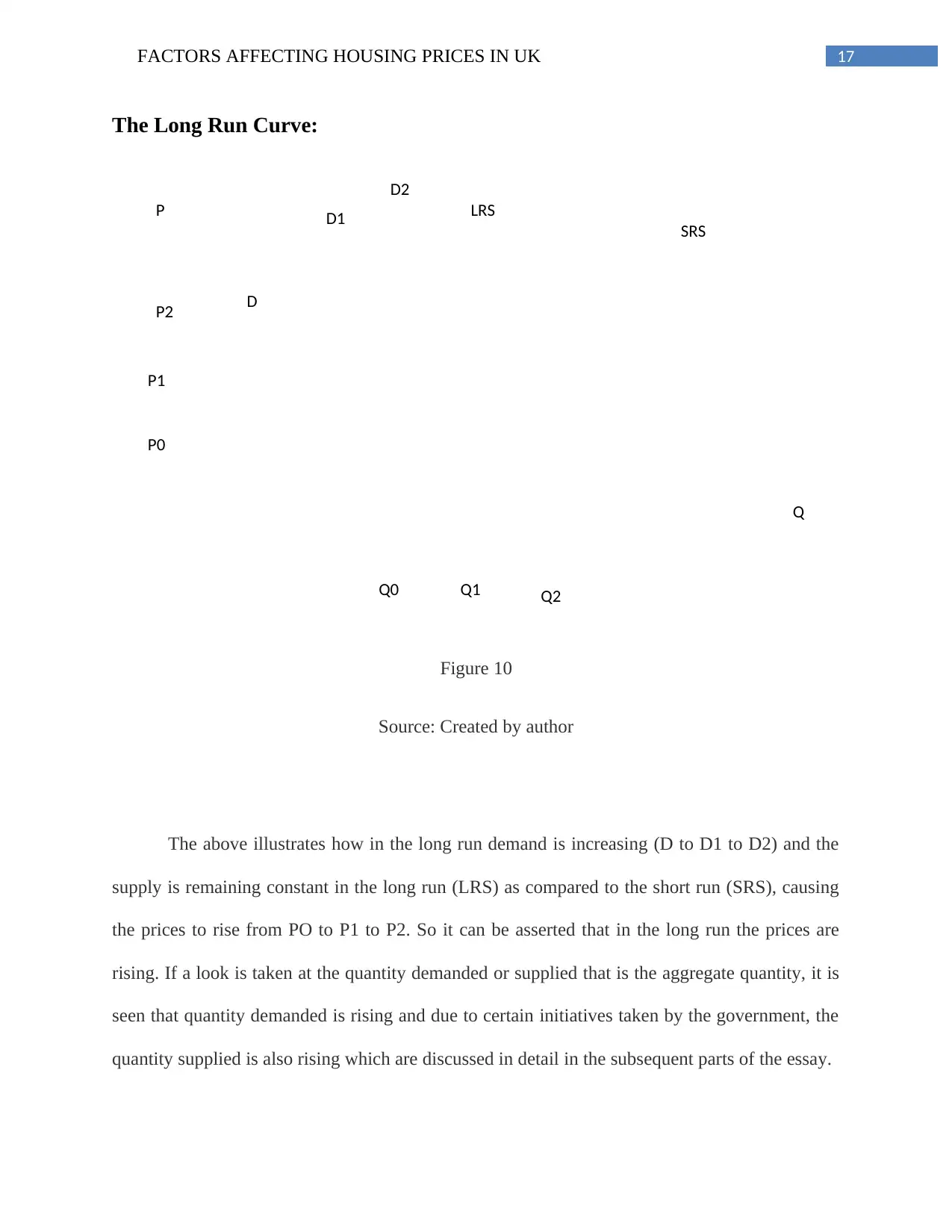
17FACTORS AFFECTING HOUSING PRICES IN UK
D
D1
D2
LRS
SRS
P
Q
P0
P1
P2
Q0 Q1 Q2
The Long Run Curve:
Figure 10
Source: Created by author
The above illustrates how in the long run demand is increasing (D to D1 to D2) and the
supply is remaining constant in the long run (LRS) as compared to the short run (SRS), causing
the prices to rise from PO to P1 to P2. So it can be asserted that in the long run the prices are
rising. If a look is taken at the quantity demanded or supplied that is the aggregate quantity, it is
seen that quantity demanded is rising and due to certain initiatives taken by the government, the
quantity supplied is also rising which are discussed in detail in the subsequent parts of the essay.
D
D1
D2
LRS
SRS
P
Q
P0
P1
P2
Q0 Q1 Q2
The Long Run Curve:
Figure 10
Source: Created by author
The above illustrates how in the long run demand is increasing (D to D1 to D2) and the
supply is remaining constant in the long run (LRS) as compared to the short run (SRS), causing
the prices to rise from PO to P1 to P2. So it can be asserted that in the long run the prices are
rising. If a look is taken at the quantity demanded or supplied that is the aggregate quantity, it is
seen that quantity demanded is rising and due to certain initiatives taken by the government, the
quantity supplied is also rising which are discussed in detail in the subsequent parts of the essay.
You're viewing a preview
Unlock full access by subscribing today!
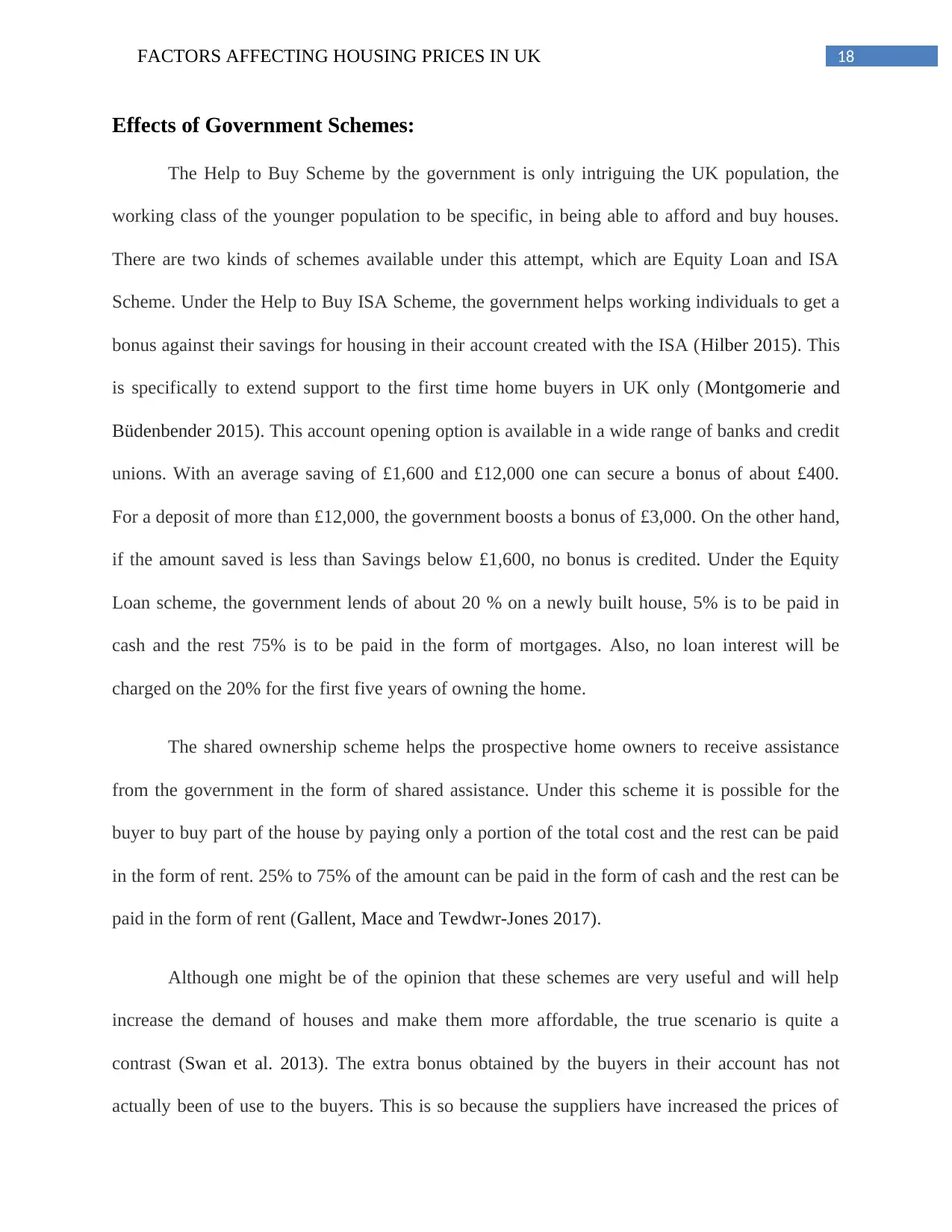
18FACTORS AFFECTING HOUSING PRICES IN UK
Effects of Government Schemes:
The Help to Buy Scheme by the government is only intriguing the UK population, the
working class of the younger population to be specific, in being able to afford and buy houses.
There are two kinds of schemes available under this attempt, which are Equity Loan and ISA
Scheme. Under the Help to Buy ISA Scheme, the government helps working individuals to get a
bonus against their savings for housing in their account created with the ISA (Hilber 2015). This
is specifically to extend support to the first time home buyers in UK only (Montgomerie and
Büdenbender 2015). This account opening option is available in a wide range of banks and credit
unions. With an average saving of £1,600 and £12,000 one can secure a bonus of about £400.
For a deposit of more than £12,000, the government boosts a bonus of £3,000. On the other hand,
if the amount saved is less than Savings below £1,600, no bonus is credited. Under the Equity
Loan scheme, the government lends of about 20 % on a newly built house, 5% is to be paid in
cash and the rest 75% is to be paid in the form of mortgages. Also, no loan interest will be
charged on the 20% for the first five years of owning the home.
The shared ownership scheme helps the prospective home owners to receive assistance
from the government in the form of shared assistance. Under this scheme it is possible for the
buyer to buy part of the house by paying only a portion of the total cost and the rest can be paid
in the form of rent. 25% to 75% of the amount can be paid in the form of cash and the rest can be
paid in the form of rent (Gallent, Mace and Tewdwr-Jones 2017).
Although one might be of the opinion that these schemes are very useful and will help
increase the demand of houses and make them more affordable, the true scenario is quite a
contrast (Swan et al. 2013). The extra bonus obtained by the buyers in their account has not
actually been of use to the buyers. This is so because the suppliers have increased the prices of
Effects of Government Schemes:
The Help to Buy Scheme by the government is only intriguing the UK population, the
working class of the younger population to be specific, in being able to afford and buy houses.
There are two kinds of schemes available under this attempt, which are Equity Loan and ISA
Scheme. Under the Help to Buy ISA Scheme, the government helps working individuals to get a
bonus against their savings for housing in their account created with the ISA (Hilber 2015). This
is specifically to extend support to the first time home buyers in UK only (Montgomerie and
Büdenbender 2015). This account opening option is available in a wide range of banks and credit
unions. With an average saving of £1,600 and £12,000 one can secure a bonus of about £400.
For a deposit of more than £12,000, the government boosts a bonus of £3,000. On the other hand,
if the amount saved is less than Savings below £1,600, no bonus is credited. Under the Equity
Loan scheme, the government lends of about 20 % on a newly built house, 5% is to be paid in
cash and the rest 75% is to be paid in the form of mortgages. Also, no loan interest will be
charged on the 20% for the first five years of owning the home.
The shared ownership scheme helps the prospective home owners to receive assistance
from the government in the form of shared assistance. Under this scheme it is possible for the
buyer to buy part of the house by paying only a portion of the total cost and the rest can be paid
in the form of rent. 25% to 75% of the amount can be paid in the form of cash and the rest can be
paid in the form of rent (Gallent, Mace and Tewdwr-Jones 2017).
Although one might be of the opinion that these schemes are very useful and will help
increase the demand of houses and make them more affordable, the true scenario is quite a
contrast (Swan et al. 2013). The extra bonus obtained by the buyers in their account has not
actually been of use to the buyers. This is so because the suppliers have increased the prices of
Paraphrase This Document
Need a fresh take? Get an instant paraphrase of this document with our AI Paraphraser
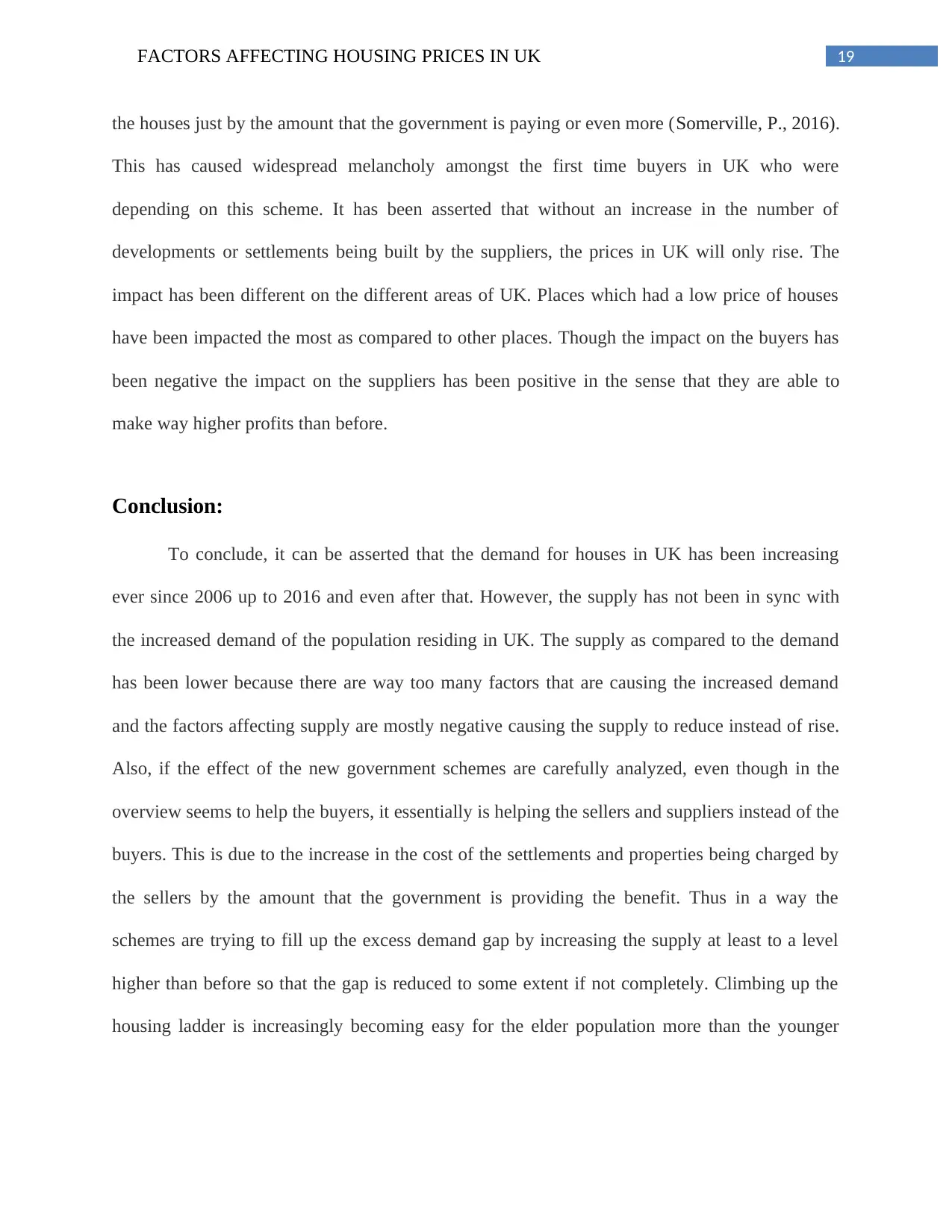
19FACTORS AFFECTING HOUSING PRICES IN UK
the houses just by the amount that the government is paying or even more (Somerville, P., 2016).
This has caused widespread melancholy amongst the first time buyers in UK who were
depending on this scheme. It has been asserted that without an increase in the number of
developments or settlements being built by the suppliers, the prices in UK will only rise. The
impact has been different on the different areas of UK. Places which had a low price of houses
have been impacted the most as compared to other places. Though the impact on the buyers has
been negative the impact on the suppliers has been positive in the sense that they are able to
make way higher profits than before.
Conclusion:
To conclude, it can be asserted that the demand for houses in UK has been increasing
ever since 2006 up to 2016 and even after that. However, the supply has not been in sync with
the increased demand of the population residing in UK. The supply as compared to the demand
has been lower because there are way too many factors that are causing the increased demand
and the factors affecting supply are mostly negative causing the supply to reduce instead of rise.
Also, if the effect of the new government schemes are carefully analyzed, even though in the
overview seems to help the buyers, it essentially is helping the sellers and suppliers instead of the
buyers. This is due to the increase in the cost of the settlements and properties being charged by
the sellers by the amount that the government is providing the benefit. Thus in a way the
schemes are trying to fill up the excess demand gap by increasing the supply at least to a level
higher than before so that the gap is reduced to some extent if not completely. Climbing up the
housing ladder is increasingly becoming easy for the elder population more than the younger
the houses just by the amount that the government is paying or even more (Somerville, P., 2016).
This has caused widespread melancholy amongst the first time buyers in UK who were
depending on this scheme. It has been asserted that without an increase in the number of
developments or settlements being built by the suppliers, the prices in UK will only rise. The
impact has been different on the different areas of UK. Places which had a low price of houses
have been impacted the most as compared to other places. Though the impact on the buyers has
been negative the impact on the suppliers has been positive in the sense that they are able to
make way higher profits than before.
Conclusion:
To conclude, it can be asserted that the demand for houses in UK has been increasing
ever since 2006 up to 2016 and even after that. However, the supply has not been in sync with
the increased demand of the population residing in UK. The supply as compared to the demand
has been lower because there are way too many factors that are causing the increased demand
and the factors affecting supply are mostly negative causing the supply to reduce instead of rise.
Also, if the effect of the new government schemes are carefully analyzed, even though in the
overview seems to help the buyers, it essentially is helping the sellers and suppliers instead of the
buyers. This is due to the increase in the cost of the settlements and properties being charged by
the sellers by the amount that the government is providing the benefit. Thus in a way the
schemes are trying to fill up the excess demand gap by increasing the supply at least to a level
higher than before so that the gap is reduced to some extent if not completely. Climbing up the
housing ladder is increasingly becoming easy for the elder population more than the younger

20FACTORS AFFECTING HOUSING PRICES IN UK
generation or for that part of the population that already has their own property in terms of
housing or real estate.
generation or for that part of the population that already has their own property in terms of
housing or real estate.
You're viewing a preview
Unlock full access by subscribing today!
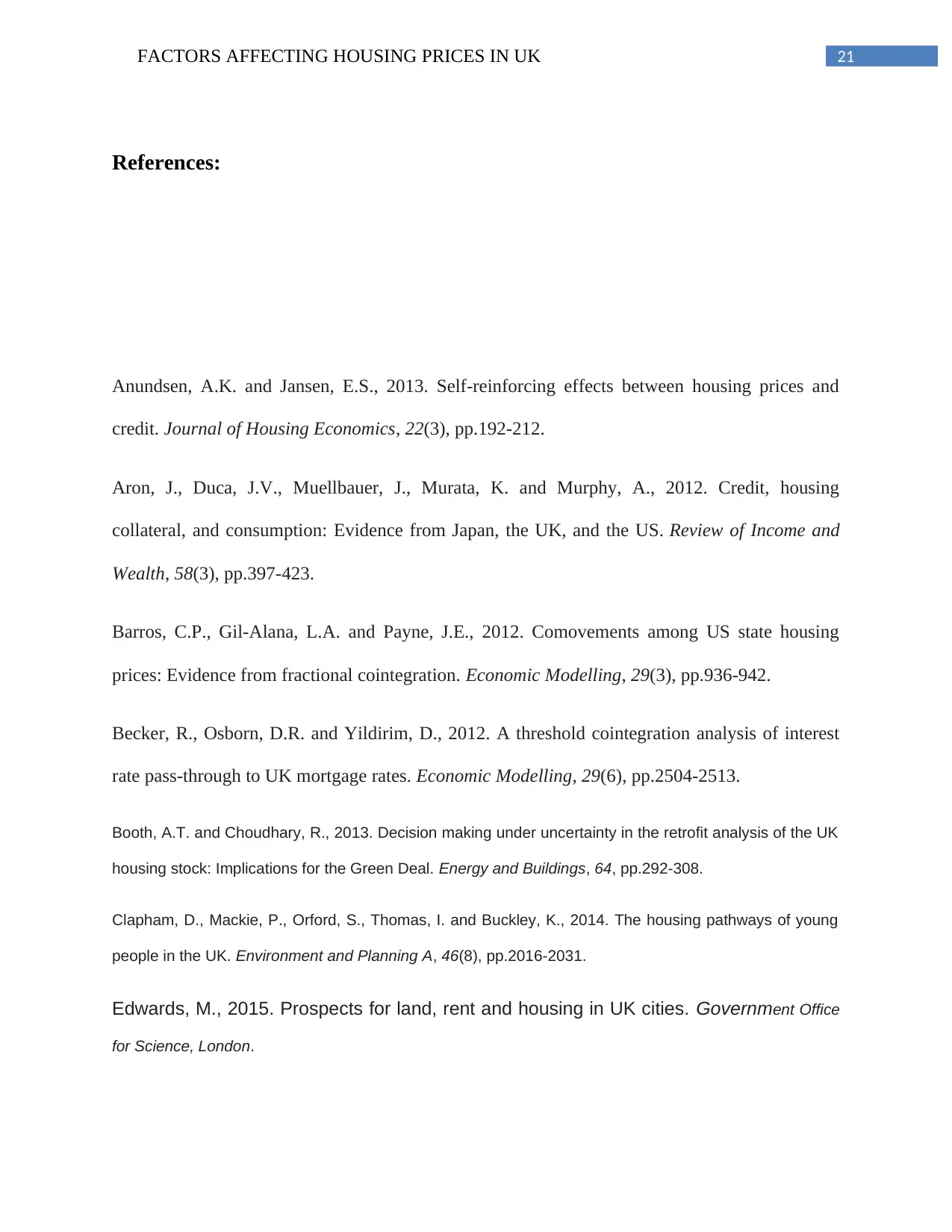
21FACTORS AFFECTING HOUSING PRICES IN UK
References:
Anundsen, A.K. and Jansen, E.S., 2013. Self-reinforcing effects between housing prices and
credit. Journal of Housing Economics, 22(3), pp.192-212.
Aron, J., Duca, J.V., Muellbauer, J., Murata, K. and Murphy, A., 2012. Credit, housing
collateral, and consumption: Evidence from Japan, the UK, and the US. Review of Income and
Wealth, 58(3), pp.397-423.
Barros, C.P., Gil-Alana, L.A. and Payne, J.E., 2012. Comovements among US state housing
prices: Evidence from fractional cointegration. Economic Modelling, 29(3), pp.936-942.
Becker, R., Osborn, D.R. and Yildirim, D., 2012. A threshold cointegration analysis of interest
rate pass-through to UK mortgage rates. Economic Modelling, 29(6), pp.2504-2513.
Booth, A.T. and Choudhary, R., 2013. Decision making under uncertainty in the retrofit analysis of the UK
housing stock: Implications for the Green Deal. Energy and Buildings, 64, pp.292-308.
Clapham, D., Mackie, P., Orford, S., Thomas, I. and Buckley, K., 2014. The housing pathways of young
people in the UK. Environment and Planning A, 46(8), pp.2016-2031.
Edwards, M., 2015. Prospects for land, rent and housing in UK cities. Government Office
for Science, London.
References:
Anundsen, A.K. and Jansen, E.S., 2013. Self-reinforcing effects between housing prices and
credit. Journal of Housing Economics, 22(3), pp.192-212.
Aron, J., Duca, J.V., Muellbauer, J., Murata, K. and Murphy, A., 2012. Credit, housing
collateral, and consumption: Evidence from Japan, the UK, and the US. Review of Income and
Wealth, 58(3), pp.397-423.
Barros, C.P., Gil-Alana, L.A. and Payne, J.E., 2012. Comovements among US state housing
prices: Evidence from fractional cointegration. Economic Modelling, 29(3), pp.936-942.
Becker, R., Osborn, D.R. and Yildirim, D., 2012. A threshold cointegration analysis of interest
rate pass-through to UK mortgage rates. Economic Modelling, 29(6), pp.2504-2513.
Booth, A.T. and Choudhary, R., 2013. Decision making under uncertainty in the retrofit analysis of the UK
housing stock: Implications for the Green Deal. Energy and Buildings, 64, pp.292-308.
Clapham, D., Mackie, P., Orford, S., Thomas, I. and Buckley, K., 2014. The housing pathways of young
people in the UK. Environment and Planning A, 46(8), pp.2016-2031.
Edwards, M., 2015. Prospects for land, rent and housing in UK cities. Government Office
for Science, London.
Paraphrase This Document
Need a fresh take? Get an instant paraphrase of this document with our AI Paraphraser
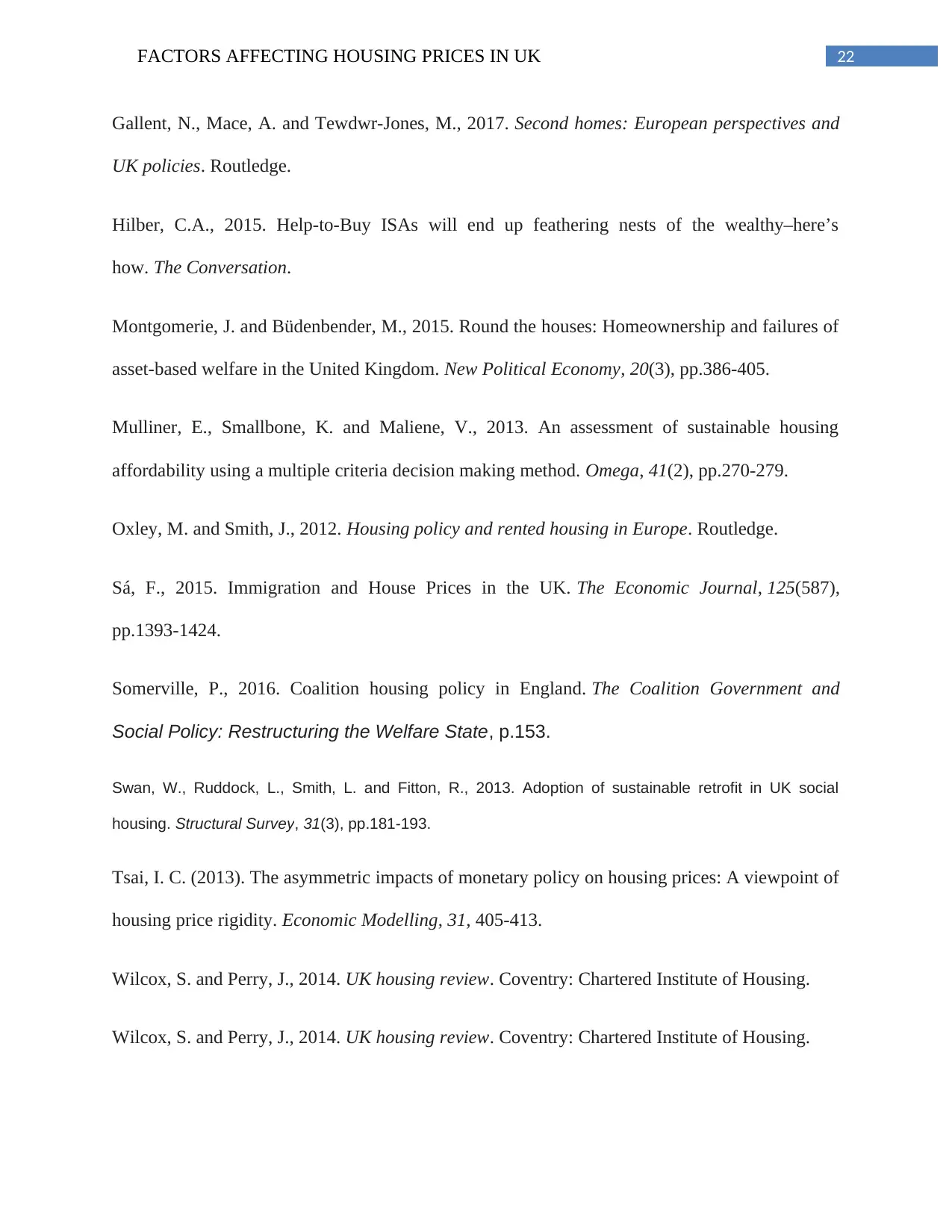
22FACTORS AFFECTING HOUSING PRICES IN UK
Gallent, N., Mace, A. and Tewdwr-Jones, M., 2017. Second homes: European perspectives and
UK policies. Routledge.
Hilber, C.A., 2015. Help-to-Buy ISAs will end up feathering nests of the wealthy–here’s
how. The Conversation.
Montgomerie, J. and Büdenbender, M., 2015. Round the houses: Homeownership and failures of
asset-based welfare in the United Kingdom. New Political Economy, 20(3), pp.386-405.
Mulliner, E., Smallbone, K. and Maliene, V., 2013. An assessment of sustainable housing
affordability using a multiple criteria decision making method. Omega, 41(2), pp.270-279.
Oxley, M. and Smith, J., 2012. Housing policy and rented housing in Europe. Routledge.
Sá, F., 2015. Immigration and House Prices in the UK. The Economic Journal, 125(587),
pp.1393-1424.
Somerville, P., 2016. Coalition housing policy in England. The Coalition Government and
Social Policy: Restructuring the Welfare State, p.153.
Swan, W., Ruddock, L., Smith, L. and Fitton, R., 2013. Adoption of sustainable retrofit in UK social
housing. Structural Survey, 31(3), pp.181-193.
Tsai, I. C. (2013). The asymmetric impacts of monetary policy on housing prices: A viewpoint of
housing price rigidity. Economic Modelling, 31, 405-413.
Wilcox, S. and Perry, J., 2014. UK housing review. Coventry: Chartered Institute of Housing.
Wilcox, S. and Perry, J., 2014. UK housing review. Coventry: Chartered Institute of Housing.
Gallent, N., Mace, A. and Tewdwr-Jones, M., 2017. Second homes: European perspectives and
UK policies. Routledge.
Hilber, C.A., 2015. Help-to-Buy ISAs will end up feathering nests of the wealthy–here’s
how. The Conversation.
Montgomerie, J. and Büdenbender, M., 2015. Round the houses: Homeownership and failures of
asset-based welfare in the United Kingdom. New Political Economy, 20(3), pp.386-405.
Mulliner, E., Smallbone, K. and Maliene, V., 2013. An assessment of sustainable housing
affordability using a multiple criteria decision making method. Omega, 41(2), pp.270-279.
Oxley, M. and Smith, J., 2012. Housing policy and rented housing in Europe. Routledge.
Sá, F., 2015. Immigration and House Prices in the UK. The Economic Journal, 125(587),
pp.1393-1424.
Somerville, P., 2016. Coalition housing policy in England. The Coalition Government and
Social Policy: Restructuring the Welfare State, p.153.
Swan, W., Ruddock, L., Smith, L. and Fitton, R., 2013. Adoption of sustainable retrofit in UK social
housing. Structural Survey, 31(3), pp.181-193.
Tsai, I. C. (2013). The asymmetric impacts of monetary policy on housing prices: A viewpoint of
housing price rigidity. Economic Modelling, 31, 405-413.
Wilcox, S. and Perry, J., 2014. UK housing review. Coventry: Chartered Institute of Housing.
Wilcox, S. and Perry, J., 2014. UK housing review. Coventry: Chartered Institute of Housing.
1 out of 23
Related Documents
Your All-in-One AI-Powered Toolkit for Academic Success.
+13062052269
info@desklib.com
Available 24*7 on WhatsApp / Email
![[object Object]](/_next/static/media/star-bottom.7253800d.svg)
Unlock your academic potential
© 2024 | Zucol Services PVT LTD | All rights reserved.





